生物工程专业英语[整理版]
生物工程专业英语单词

糖
sugar
tRNA
transferRNA
酶
enzyme
溶酶体
lysosome
R基
R-Group
细胞核
nucleus
生物体
organism
胰腺
pancreas
小分子
micromolecule
专业的;特化
specialized
有机物
organic
大分子
macromolecule
细胞器
organelle
电子
electron
延长、拉长
elongate
染色
stain
原子核
nucleus
完全相同的
identical
瘫痪
paralysis
复制、折叠
replicate
外显子
exon
杂交
hybridization
藻类
algae
内含子
intron
合成
synthetic
流行病学
epidemiology
终止子
terminator
遗传
inheritance
密码子
codon
固氮
fix nitrogen
相互作用
interaction
三联密码子
triplet
酿
brewing
核苷酸碱基
nucleotidebases
内质网
endoplasmic reticulum
A
Adenine
氨基酸
amino acid
杂种
mule
T
Thymine
简并性
生物工程专业英语1
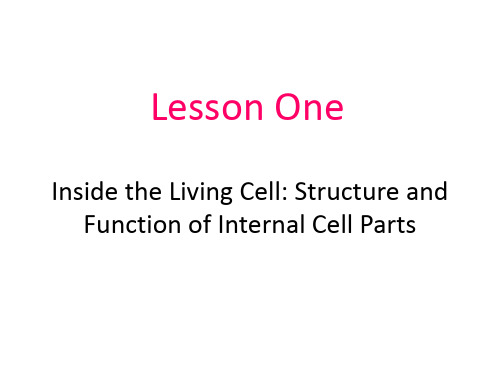
2.
The Nucleus: Information Central The eukaryotic cell nucleus is the largest organelle and houses the genetic material(DNA) on chromosomes. (In prokaryotes the hereditary material is found in the nucleoid.) The nucleus also contains one or two organelles-the nucleolithat play a role in cell division.
Glossary:
Cyto--- 细胞 Cytology:细胞学 Cytoplasm:细胞质 Cytokinesis:胞质分裂 Cytoskeleton:细胞骨架 Cytobiology:细胞生物学 Cytocentrum:中心体
chloroplast:叶绿体 chlorophyll:叶绿素 carotenoid:类胡萝卜素: carotene:胡萝卜素 lutein: 叶黄素 Accessory pigment: 辅助色素
• Ribosome 核糖体 • Small structures composed of two protein and ribonucleic acid subunits involved in the assembly of proteins from amino acids
The number of ribosomes within a cell may range from a few hundred to many thousands. This quantity reflects the fact that, ribosomes are the sites at which amino acids are assembled into proteins for export or for use in cell processes. 核糖体的数量变化从几百到几千,核糖体是氨基酸组 装成蛋白质的重要场所。
生物工程专业英语
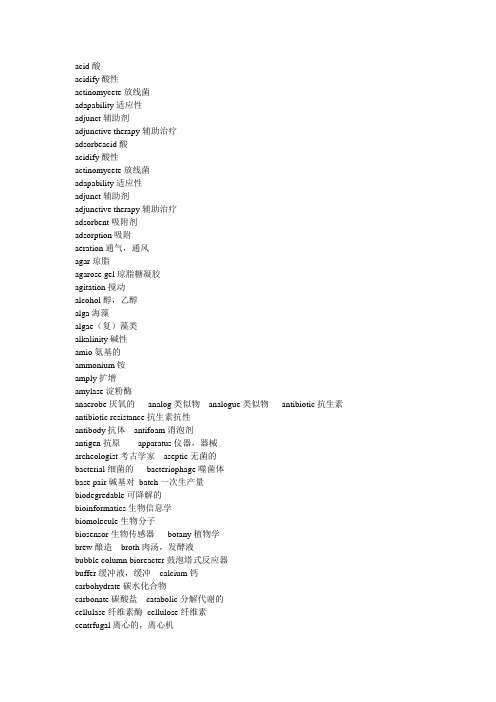
acid酸acidify酸性actinomycete放线菌adapability适应性adjunct辅助剂adjunctive therapy辅助治疗adsorbeacid酸acidify酸性actinomycete放线菌adapability适应性adjunct辅助剂adjunctive therapy辅助治疗adsorbent吸附剂adsorption吸附aeration通气,通风agar琼脂agarose gel琼脂糖凝胶agitation搅动alcohol醇,乙醇alga海藻algae(复)藻类alkalinity碱性amio氨基的ammonium铵amply扩增amylase淀粉酶anaerobe厌氧的analog类似物analogue类似物antibiotic抗生素antibiotic resistance抗生素抗性antibody抗体antifoam消泡剂antigen抗原apparatus仪器,器械archeologist考古学家aseptic无菌的bacterial细菌的bacteriophage噬菌体base pair碱基对batch一次生产量biodegredable可降解的bioinformatics生物信息学biomolecule生物分子biosensor生物传感器botany植物学brew酿造broth肉汤,发酵液bubble column bioreacter鼓泡塔式反应器buffer缓冲液,缓冲calcium钙carbohydrate碳水化合物carbonate碳酸盐catabolic分解代谢的cellulase纤维素酶cellulose纤维素centrfugal离心的,离心机centrifugation离心法,离心centrifuge离心机chemostat恒化器chitin几丁质chloroplast叶绿体chromatography色谱chromosome染色体citric acid柠檬酸clarification澄清clone克隆clone library克隆文库cloning vector克隆载体coefficient系数colony菌落colorimeter比色计comparison比较,对照complementrary互补的component成分,组分composition组成compound化合物concentration浓缩,浓度conformation构象contamination污染,污染物crystallisation结晶化decomposition分解,腐烂decontaminate净化deficient缺乏的degrade降解,降级deplete使衰竭,耗尽deposite沉淀物,沉淀detoxification解毒devoid缺乏的dextran葡萄糖diameter直径digest消化,酶切diluent稀释的,稀释液dilute稀释dilution稀释disintegrant崩解剂disintegration瓦解dissociate解里,游离dissolve溶解double helix双螺旋double stranded双链的downcomer下流管,溢流管,液降duplicate使重复,复制electrophoresis电泳enzyme酶eradication根除eukaryote真核细胞exaggerate使增大,使夸大exceed超过,胜过expertise专门技术expression vector表达载体extracellular细胞外的fabricate虚构,制作,伪造feedback反馈fermentation发酵fermenter发酵罐filter过滤,过滤器filtration过滤flask烧瓶。
生物工程专业英语单词(精品范文).doc

plasmid
白灵药
panacea
常染色体
autosomal chromosomes
性染色体
sex chromosome
红细胞
red blood cell
生殖细胞
germ cell
端粒
telomere
转化
transformation
插入
adding
精子
sperm
提取
extract
敲除
removing
Tip
链球菌
streptoccus
原生质体
cytoplasm
微生物
Microbe(s)
杆菌
bacillus
细胞壁
cell wall
Microorganism
弧菌
vibrio
染色体
chromosome
肉眼
Unaided eye
螺旋杆菌
spirillum
核糖体
ribosome
生态系统
ecosystem
新陈代谢
遗传
inheritance
密码子
codon
固氮
fix nitrogen
相互作用
interaction
三联密码子
triplet
酿
brewing
核苷酸碱基
nucleotidebases
内质网
endoplasmic reticulum
A
Adenine
氨基酸
amino acid
杂种
mule
T
Thymine
简并性
metabolism
叶绿体
chloroplast
生物工程专业英语单词
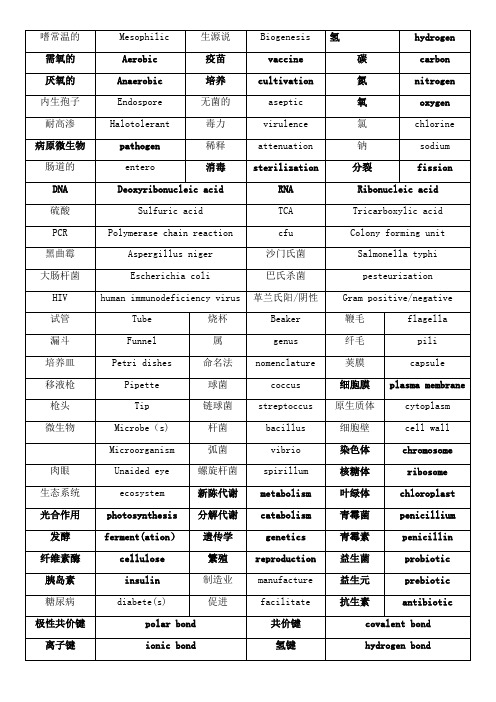
制造业
manufacture
益生元
prebiotic
糖尿病
diabete(s)
促进
facilitate
抗生素
antibiotic
极性共价键
polar bond
共价键
covalent bond
离子键
ionic bond
氢键
hydrogen bond
原子
atom
底物
substrate
色素
(photo)pigment
metabolism
叶绿体
chloroplast
光合作用
photosynthesis
分解代谢
catabolism
青霉菌
penicillium
发酵
ferment(ation)
遗传学
genetics
青霉素
penicillin
纤维素酶
cellulose
繁殖
reproduction
益生菌
probiotic
胰岛素
电子
electron
延长、拉长
elongate
染色
stain
原子核
nucleus
完全相同的
identical
瘫痪
paralysis
复制、折叠
replicate
外显子
exon
杂交
hybridization
藻类
algae
内含子
intron
合成
synthetic
流行病学
epidemiology
终止子
terminator
质粒
plasmid
生物工程专业英语单词

precursor
裂解性噬菌体
lytic cycle
机制,机理
mechanism
膳食纤维
dietary fiber
溶源性噬菌体
lysogenic cycle
传统的
conventional
生物多样性
biodiversity
衣壳
capsid
合成,混合
compound
耕种
tillage
成熟
maturation
毒力
virulence
氯
chlorine
病原微生物
pathogen
稀释
attenuation
钠
sodium
肠道的
entero
消毒
sterilization
分裂
fission
DNA
Deoxyribonucleic acid
RNA
Ribonucleic acid
硫酸
Sulfuricacid
TCA
Tricarboxylic acid
反转录PCR
reverse transcriptase PCR
最适条件
optimal condition
实时定量PCR
Realtime PCR
性状
trait
RNA剪切
RNA slicing
核酸
nucleic acid
遗传学
heredity/genetic
糖主链
sugar backbone
育种
breeding
synthesis
生物降解
bioremediation
启动子
promoter
生物工程专业英语整理
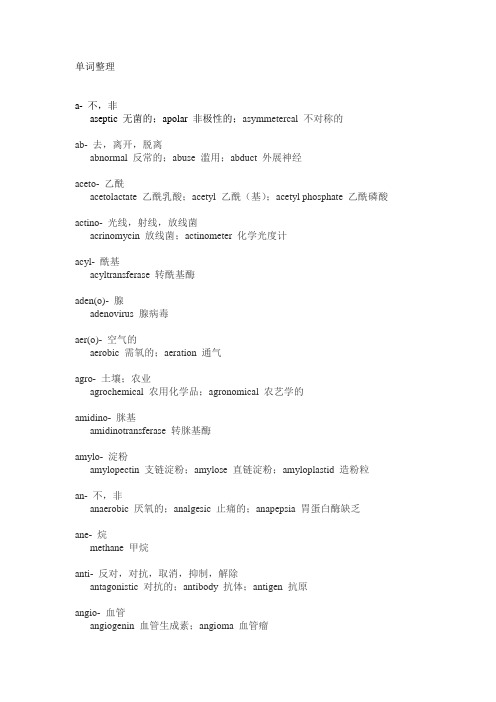
单词整理a- 不,非aseptic 无菌的;apolar 非极性的;asymmetercal 不对称的ab- 去,离开,脱离abnormal 反常的;abuse 滥用;abduct 外展神经aceto- 乙酰acetolactate 乙酰乳酸;acetyl 乙酰(基);acetyl phosphate 乙酰磷酸actino- 光线,射线,放线菌acrinomycin 放线菌;actinometer 化学光度计acyl- 酰基acyltransferase 转酰基酶aden(o)- 腺adenovirus 腺病毒aer(o)- 空气的aerobic 需氧的;aeration 通气agro- 土壤;农业agrochemical 农用化学品;agronomical 农艺学的amidino- 脒基amidinotransferase 转脒基酶amylo- 淀粉amylopectin 支链淀粉;amylose 直链淀粉;amyloplastid 造粉粒an- 不,非anaerobic 厌氧的;analgesic 止痛的;anapepsia 胃蛋白酶缺乏ane- 烷methane 甲烷anti- 反对,对抗,取消,抑制,解除antagonistic 对抗的;antibody 抗体;antigen 抗原angio- 血管angiogenin 血管生成素;angioma 血管瘤aut(o)- 自己的,自动的autotroptic 自养的;autonomous 自发的;autosensitization 自身致敏bio- 生物的biochemistry 生物化学;bioamine 生物胺;biocatalyst 生物催化剂bromo- 溴的5-bromouracil 5-溴尿嘧啶bis- 双,二bisexualism 雌雄异体;bisphenols 双酚类brady- 缓慢hradycardia 心动过缓;bradykinin 缓激肽carb(o)- 碳的carbodiimide 碳二亚胺;carbohydrate 碳水化合物carboxy(l) 羧基carboxy methylcellulose 羧甲基纤维素carcin(o)- 癌carcinogen 致癌物cardio- 心脏cardiotonic 强心的cent(i)- 一百的,百分之一的,厘century 世纪;centimeter 厘米;centimorgan 厘摩chemo- 化学chemoautotrophy 化能自养;chemosynthesis 化能合成;chemoattractant 化学引诱物chlor- 氯,绿chloramphenicol 氯霉素;chlorobenzene 氯苯;chloroplast 叶绿体chrom(o)- (chromat(o)-) 颜色chromatid 染色单体;chromosome 染色体;chromatography 色谱法cis- 顺cistrion 顺反子;cis regulation 顺式调节;cis-isomer 顺式异构体co- 一起,共同cooperate 合作;coincide 重合;cognate 同源的con- (col-,com-,cor-)连同,一起complexant 络合剂;concentrate 集中;combine 结合contra- 反对,相反contrast 对照;contrary 相反的;contrasuppression 反抑制counter- 反,逆couner-circulation 逆向循环;counter-ecolution 逆进化;counter receptor 反受体cryo- 寒冷,冷冻cryopreservation 冷冻保藏;cryogen 冷冻剂;cryophile 适寒性cyano- 青,蓝,氰cyanobacteria 蓝细菌;cyanocobalamin 氰钴胺素;cyanogen bromide 溴化氰de- 否定,除去,离开,降低,脱debug 排除故障;deceleration 降速;degeneration 退化deca- 十,葵decahedron 十面体;decane 葵烷;decamer 十聚体deoxy- 脱氧deoxycytosine 脱氧胞嘧啶di- 二,二倍,二重diploid 二倍体;dimer 二聚体;divinylbenzene 二乙烯苯dia- 横穿diameter 直径;dialysis 透析;diaphragm 隔膜dis- 否定,分离disintegration 破碎;disagree 不同意;dissemination 散播dodeca- 十二dodecahedron十二面体;dodecane 十二烷;dodecamer 十二聚体eco- 生态,居处,宿主ecogentics 生态遗传学;ecology 生态学;ecomone 生态信息素ectoblast 外胚层;ectohormone 外激素;ectodomain 胞外结构electr(o)- 电electrodialysis 电渗析en-(em-) 使成为,置于……中enable 能够;encode 编码;embed 包埋end(o)- 内endergonic 吸能的;endospore 内生孢子enol 烯醇phosphoenolpyruvate 磷酸烯醇丙酮酸enter(o)- 肠enteroacteria 肠细菌;enterobactin 肠杆菌素;enterocyte 肠细胞epi- 表;变化epichlorohydrin 表氯醇;epimerase 差向异构体酶;epithelial cell 上皮细胞erythr(o)- 红,赤erythrose 赤藓糖;erythromycin 红霉素;erythrocyte 红细胞eu- 真正eukaryote 真核生物;eukaryocyte 真核细胞;eubacteria 真细菌e(x)- 向外,超出,完全,彻底explant 外植体;elongate 拉长;evaluate 评价ex(o)- 外,在外,产生exothermic 放热的;exergonic 放能的;exogenous gene 外源基因extra- 超出extracellular 胞外的;extract 抽提物;extracellular virus 胞外病毒ferri- 高铁ferricytochrome 高铁细胞色素;ferritin 铁蛋白;ferridoxin 铁氧还原蛋白ferro- 亚铁ferrocytochrome 亚铁细胞色素;ferroheme 血红素;ferrochelatase 亚铁螯合酶flavanol 黄烷酮;flavin 黄素;flavone 黄酮fluoro- 氟基,氟代,荧光fluorochrome 荧光染料;fluoroacetate 氟乙酸;fluorometer 荧光剂formyl- 甲酰formyltetrahydrofolate 甲酰四氢叶酸;formyl 甲酰基;formylation 甲酰化geo 土地geographical barrier 地理障碍;geographical isolation 地理隔离;geosmin 土腥味素glyc(o)- 糖glycoprotein 糖蛋白hem(o,a)-,haem(o,a)-,haemat(o)-血的hemoglobin 血红蛋白;haemagglutinin 血凝素;haem 血红素hemi- 半hemicellulase 半纤维素;hemizygote 半合子;hemiacetal 半缩醛heter(o)- 异,杂,异种heterogeneous 异质的,不均一的;heterotrophic 异养的;heteroantigen 异种抗原hepato- 肝hepatocarcinoma 肝癌;hepatocyte 肝细胞;hepatotoxin 肝脏毒素homeo- 同源,同祖homeotic gene 同源异形基因hom(o)- 相同homogeneous 同质的,均一的;homologous 同源的;homoeosis 同源异形hydr(o)- 水,液体,氢hydrocarbon 烃;hydrocolloid 水胶体;hydrobios 水生生物hydroxy(l) 羟基hydroxyapatite 羟磷灰石;hydroxylase 羟化酶hyper- 超出,过度hyperfiltration 反渗透;hypertension 高血压hypo- 低,(过)少sodium hypochlorite 次氯酸钠;hypoblast 下胚层;hypoimmunity 低免疫性imino- 亚胺基iminodiacetic acid 亚胺基二乙酸immuno- 免疫immunogenic 致免疫的;immunoassay 免疫分析in-(il-,im-,ir-)不,无;在内,入内insoluble 不能溶解的;insuperable 不能克服的;impermeable 不能渗透的infra- 下面,内部infrastructure 基础结构;infrared 红外线的inter- 相互,在……之间interact 相互作用;intergeneric 属间的;inter-particle 颗粒间的intra- 在内,向内intraspecific 种内的;intra-particle 颗粒内的;intravenous 进入静脉的iodo- 碘基,碘代iodometry 碘量法;iodouracil 碘尿嘧啶;iodoacetic acid 碘乙酸iso- 同,等,异isomer 同分异构体;isomerase 异构酶;isobutyl 异丁基kary(o)- 核,细胞核karyology 胞核学keto- 酮基ketohexulose 酮己酮糖;keto acid 酮酸;ketoamin 酮胺lacto- 乳lactobacillus 乳杆菌属;lactogen 催乳素;lactoglobulin 乳球蛋白leuco- 白,无色的leucocyte 白细胞lipo- 脂lipoprotein 脂蛋白;lipoxygenase 脂氧合酶lympho- 淋巴lymphocyte 淋巴细胞macro- 大的,宏观的macromolecule 大分子;macroporous 大孔的mal- 不当,不良malabsorption 吸收不良;malassimulation 同化不全;malnutrition 营养不良megal(o)- 巨大cytomegalovirus 巨细胞病毒mercapto- 巯基β-mercaptoethylamine β-巯基乙胺meso- 内消旋;中(间)meso inositol 内消旋肌醇;mesophilic 嗜温的meth- 甲基methacrylate 甲基丙烯酸methyl 甲基methyltroph 甲基营养菌micro- 微,微小的microscope 显微镜;microcarrier 微载体;microbe 微生物mono- 一,单,单一monoclonal 单克隆的;monolayer 单层multi- 多,多方面multistage 多级;multicellularity 多细胞性;myco- 真菌mycolytic 溶真菌的;mycotoxin 真菌毒素;mycoprotein 真菌蛋白myelo- 髓鞘,髓myeloblast 成髓细胞;myelocyte 髓细胞;myeloma 骨髓瘤myo- 肌myoalbumin 肌白蛋白;myoblast 成肌细胞;myocyte 肌细胞nano- 纳nanobacteria 微小细菌;nanosecond 纳秒;nanotechnology 纳米技术neo- 新neocarcinostatin 新制癌菌素;neocerebellum 新小脑;neomycin 新霉素neur(o)- 神经neural 神经的;neurotoxin 神经毒素nitro- 硝基nitrofuran 硝基呋喃;nitroalkane 硝基烷;nitrobacteria 硝化细菌nucle(o)- 核nucleoside 核苷;nucleophilic 亲核的non- 非,无,不non-newtonian fluid 非牛顿型流体;non-aqueous solution 非水溶液nor- 去甲,正noradrenalin 去甲肾上腺素;normal 正常,正交;normocyte 正红细胞over- 在上面,超过,过overshooting 过调节;overview 简明概述;overcooled 过冷的oligo- 寡oligosaccharide 寡糖,低聚糖onco- 肿瘤oncogene 致癌基因ovo- 卵ovocenter 卵中心体;ovorubin 卵红蛋白;ovum 卵细胞oxalo- 草酰,乙二酸-酰基oxalo acetate 草酰乙酸oxy- 氧;羟基deoxyguanosine 脱氧鸟苷;oxytetracycline 土霉素;oxyproline 羟脯氨酸path(o)- 病pathogen 病原菌para- 旁(位),对(位),副parabronchus 复支气管;parathyroid gland 甲状旁腺;paraoxon 对氧磷peri- 周,周围perimeter 周长;periplasmic space 周质间隙;periblast 胚周区per- 过peroxisome 过氧化质体phenyl 苯基phenylalanine 苯丙氨酸phospho- 磷酸基phosphofructokinase 磷酸果糖激酶phosphoryl- 磷酰基phosphorylation 磷酸化作用phyto- 植物phytoalexin 植物抗毒素;phytology 植物学;phytoplankton 浮游植物plasm(o)- 原生质,血浆plasmolemma 质膜pleio- 多pleiotropic 多效的;pleioxeny 多主寄生;pleiotropy 多效性poly- 多,聚polysaccharide 多糖;polystyrene 聚苯乙烯;polyacid 多酸post- 后post-transcriptional modification 转录后修饰作用;post-exponential growth phase 后对数生长期pre- 前,在前premature 过早的;precursor 前体;premise 前提pro- 原,前prokaryote 原核生物;prostate 前列腺proteo- 蛋白proteolipid 蛋白脂质;proteome 蛋白质组;proteolysis 蛋白酶解proto- 原始,初prototype 原型;protoplast 原生质体pseud(o)- 假的pseudo-plastic fluid 假塑性流体;psudodominance 假显性;pseudohypha 假菌丝pyro- 焦,火,热pyrophosphorylase 焦磷酸化酶;pyrogen 热源;progenic exotoxin 热源性外毒素quasi- 类似,准quasi-homogeneous 准均匀的radio- 辐射,放射autoradiography 放射自显影;radiotracer 放射性示踪物;radiology 放射学re- 再,重新,反复recirculation 循环;reversion 回复;reactivity 反应性retro- 后,向后,回复retrovirus 逆转录病毒ribo- 核糖riboflavin 核黄素;ribonucleic acid 核糖核酸;ribonucleotide 核糖核苷酸self- 自身的self-fertilization 自体受精semi- 半,部分semi-permeable membrane 半透膜;semi-synthetic 半合成的;semiconservative replication 半保留复制sero- 血清serological 血清学;seroconversion 血清转变soma- 体soma 体质,胞体;somatic cell 体细胞;somatization 体部分化somato- 生长somatocrinin 生长素释放肽;somatotroph 促生长素细胞;somatotropin 促生长素,生长激素sub- 下面,次于,近于subcellular 亚细胞的;subunit 亚基;subdivide 再分super- 上,上面,超,超级superior 上面的;supernatant 上清液的syn-(sym-) 共同,合synchronize 同步;symbiosis 共生现象;synergistic 协同作用的techn(o)- 技术,工艺technology 技术(学),工艺学;technique 技术therm(o)- 热thermistor 热敏电阻;themometer 温度计thi(o)- 硫,硫代thiamine 硫胺素;thioacylation 硫代酰化;thiokinase 硫激酶thym(o)- 胸腺thymosin 胸腺素toti- 全,全部,整个totipotency 全能性trans- 横穿,通过,转移transformation 转化;transcribe 转录;transposen 转位子tri- 三,三次,三级triplet 三联体;triangle 三角形;triacylglycerol 三酰甘油ultra- 超,极端,过分ultrasonic 超声波;ultracentrifugation 超离心un- 不,相反,出去unfold 展开under- 下面,低于,不足undergraduate 大学本科生;underpin 加固……的基础uni- 单,一,同一uninucleate 单核的;unique 独一无二的up- 向上,在上upstream 上游;upright 直立的uro- 尿urokinase 尿激酶vinyl- 乙烯基polyvinylchloride 聚氯乙烯后缀:-able(-ible) 可能的practicable 可行的;responsible 负责的-ability 能力acceptability 可接受性;permeability 渗透性-age 表示动作过程、量spillage 溢出;percentage 百分比-al 接在名词后形成形容词,接在动词后形成名词personal 个人的;exceptional 例外的;refusal 拒绝-aldehyde 醛glutaraldehyde 戊二醛-amin 胺methylamine 甲胺-ane 烷methane 甲烷-ant 动作者inactivant 失活剂;bioprotectant 生物保护剂-ase 酶protease 蛋白酶;polymerase 聚合酶-ate 盐,酯phosphate 磷酸盐;sebacate 奎二酸酯-cide 杀害,消灭suicide 自杀;bactericide 杀菌剂;amoebicide 抗阿米巴药-cyte 细胞leucocyte 白细胞-derm 皮,皮层blastoderm 胚层;dermadrone 内病性皮疹-ene 烯ethylene 乙烯-(e)ry 场所;一类事物bakery 面包房;circuitry 电路系统;poultry 家禽-fold 倍twofold 两倍-(i)fy 接名词或形容词后构成动词solidify 固化;simplify 简化-gen 原,剂antigen 抗原;mutagen 诱变剂;carcinogenic 致癌的-gram 图形;记录的东西chromatogram 色谱图;polarograph 极谱图-graphy 描绘、记录的方式、学科chromatography 色层分离法;autoradiography 放射自显影术-ic anhydride 酸酐sodium chloride 氯化钠-imine 亚胺iminodiacetic acid 亚胺基二乙胺-ish 略带一点的greyish 浅灰色的-ist ……的实行者,……专业人员(专家)scientist 科学家;geneticist 遗传学家-itis 炎,发炎hepatitis 肝炎;encephalitis 脑炎-ize(-ise) 使成为atomize 雾化;oxidize 使氧化-lactone 内酯β-propiolactone β-丙醇酸内酯-lemma 皮,壳,鞘膜basilemma 基底膜;lemmatoxin 鞘毒素-less 无,不,不能stainless 不锈的-like 如……样的sponge-like 海绵状的-(o)logy(-ological,形容词)学科biology 生物学;technology 技术学,工艺学;toxicology 毒理学的-lysis 分解作用,过程glycolysis 糖酵解作用;hydrolysis 水解作用;analysis 分析-lytic(形容词,分解的)-lyze(-lise)(动词,分解)-lysate(名词,分解液)hydrolytic 水解的;hydrolyze 水解;hydro-lysate 水解液-ment 在动词后构成名词development 发展;entrainment 夹带-meter 计,表spectormeter 发光剂;viscometer 粘度计-metric 测量的gravimetric (测定)重量的;volumetric (测定)体积的;potentiometric (测量)电位的-mycete 霉菌streptomycete 链霉菌-mycin 霉素,菌素mitomycin 丝裂霉素;actinomycin 放线菌素-nema 丝,线amphinema 偶线;chromonema 染色体;nemacicide 杀线虫剂-oid 类,似,……样、状的acidoid 似酸的;amyloid 淀粉样的;carotenoid 类胡萝卜素-ol 醇butanol 丁醇;inositol 肌醇-oma 瘤myeloma 骨髓瘤;hybridoma 杂交瘤-one 酮phenoxazinone 吩噁嗪酮-ory 构成形容词transitory 短暂的;respiratory 呼吸的;构成名词,表场所depository 储藏所-ose 糖heptose 庚糖;lactose 乳糖-oside 糖苷galactoside 半乳糖苷;cardiac glycoside 强心苷-osis 病,症;acalcicosis 缺钙症;hepatitis 肝炎-ous 构成形容词extraneous 外来的;rigorous 严格的-philic 亲……的lipophilic 亲脂性的;hydrophilic 亲水的-phobic 疏……的hydrophobic 疏水的-phoresis 移动electrophoresis 电泳-phil 亲,嗜,喜acidopil 嗜酸的;aerophil 好气的-plasm 血浆,原生质protoplasm 原生质-plast 原始细胞,(质)体,血浆centroplast 中心质体;hematoplast 成血细胞;plasmolemma 质膜-proof 耐……的flame-proof 耐火的;explosion-proof 防爆的-side 苷nucleside 核苷;glycoside 糖苷-sis 构成名词,表示作用,过程mutagenesis 诱变作用;mitosis 有丝分裂;meiosis 减速分裂-some 体,粒chromosome 染色体;idiosome 核旁体;ribosome 核糖体-stat 稳定装置chemostat 恒化器-taxis,tropism 趋向性aerotaxis 趋氧性;chemiotaxis 趋化性;lipotropism 亲脂性-tion(-ation,-ition,-sion) 构成名词instrumentation 仪表化;trypsinization 胰蛋白消化酶;adhesion 粘着-tide 甘酸,肽deoxyribotide 脱氧核苷酸;propeptide 前肽-troph ……营养生物,……营养型(-trophic 构成形容词)methanotroph 甲烷营养型;autotroph 自养生物;autotrophic 自养的-wise 接名词或形容词后构成副词batchwise 分批的;likewise 同样的。
生物工程专业英语单词

生物工程专业英语单词内生孢子Endospore 无菌的aseptic 氧oxygen 耐高渗Halotolerant 毒力virulence 氯chlorine 病原微生物pathogen 稀释attenuation 钠sodium 肠道的entero 消毒sterilization 分裂fission Deoxyribonucleic acid RNA Ribonucleic acidSulfuric acid TCA Tricarboxylic acid Polymerase chain reaction cfu Colony forming unit 黑曲霉Aspergillus niger 沙门氏菌Salmonella typhi大肠杆菌Escherichia coli 巴氏杀菌pesteurization human immunodeficiency virus 革兰氏阳/阴性Gram positive/negativeTube 烧杯Beaker 鞭毛flagellaFunnel 属genus 纤毛pili 培养皿Petri dishes 命名法nomenclature 荚膜capsule 移液枪Pipette 球菌coccus 细胞膜plasma membrane胰岛素insulin 制造业manufacture 益生元prebiotic 糖尿病diabete(s) 促进facilitate 抗生素antibiotic 极性共价键polar bond 共价键covalent bond 离子键ionic bond 氢键hydrogen bondatom 底物substrate 色素(photo)pigment electron 延长、拉长elongate 染色stainidentical 瘫痪paralysis 原子核nucleus 完全相同的复制、折叠replicate 外显子exon 杂交hybridization algae 内含子intron 合成synthetic流行病学epidemiology 终止子terminator synthesis生物降解bioremediation 启动子promoter 同时地simultaneously 防腐剂preservative 转录transcription 噬菌体bacteriophage 洗涤剂detergent 翻译translation 颗粒particleAdenine 氨基酸amino acid 杂种muleThymine 简并性degenerate 小麦wheatGuanine 调控regulate 大麦barleyCytocine 神经元neuron 玉米maze/cornUracil 成纤维细fibroblast 大豆soybean胞strand 肌肉细胞muscle cell 高粱sorghum orientation 源于;得自derive 谷物cereal primer 表明;指出indicate 豆类legume complementary 分离isolate 穗panicle sequence 扩增amplification 生理盐水saline单倍体hyploid 载体vector 胆固醇chloesterol 双倍体diploid 质粒plasmid 白灵药panacea 常染色体autosomal chromosomes 性染色体sex chromosome作业。
最新生物工程专业英语单词(1)
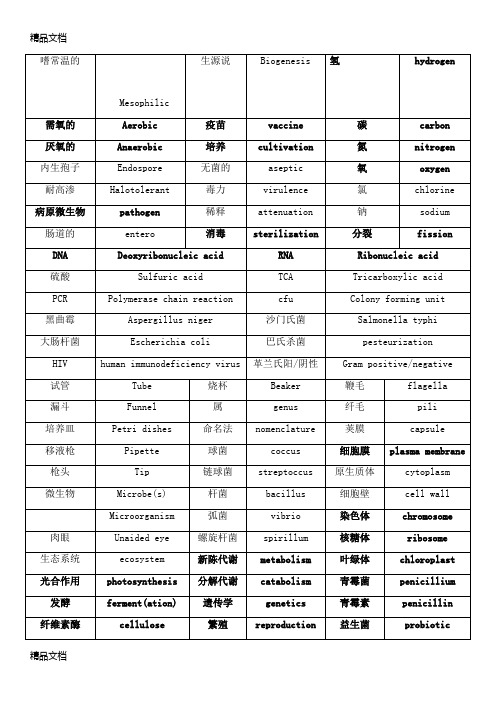
Adenine
氨基酸
amino acid
杂简并性
degenerate
小麦
wheat
G
Guanine
调控
regulate
大麦
barley
C
Cytocine
神经元
neuron
玉米
maze/corn
U
Uracil
成纤维细胞
fibroblast
大豆
soybean
链
strand
肌肉细胞
TCA
Tricarboxylic acid
PCR
Polymerase chain reaction
cfu
Colony forming unit
黑曲霉
Aspergillus niger
沙门氏菌
Salmonella typhi
大肠杆菌
Escherichia coli
巴氏杀菌
pesteurization
HIV
muscle cell
高粱
sorghum
定位
orientation
源于;得自
derive
谷物
cereal
引物
primer
表明;指出
indicate
豆类
legume
互补
complementary
分离
isolate
穗
panicle
序列
sequence
扩增
amplification
生理盐水
saline
单倍体
球菌
coccus
细胞膜
plasma membrane
枪头
Tip
生物工程专业英语单词
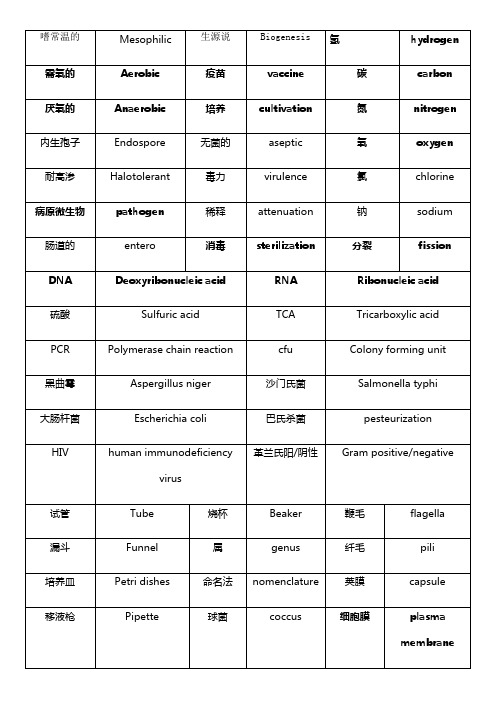
solid-state fermentation
生物反应器
fermentor
bioreactor
甘油三酯
triglycerides
乳糖
lactose
希拉细胞
Hela cell
mRNA
messengerRNA
蔗糖
sucrose
蛋白质
protein
rRNA
ribosomal RNA
核糖
ribose
反转录PCR
reverse transcriptase PCR
最适条件
optimal condition
实时定量PCR
Realtime PCR
性状
trait
RNA剪切
RNA slicing
核酸
nucleic acid
遗传学
heredity/genetic
糖主链
sugar backbone
育种
breeding
革兰氏阳/阴性
Gram positive/negative
试管
Tube
烧杯
Beaker
鞭毛
flagella
漏斗
Funnel
属
genus
纤毛
pili
培养皿
Petri dishes
命名法
nomenclature
荚膜
capsule
移液枪
Pipette
球菌
coccus
细胞膜
plasma membrane
枪头
PCR
Polymerase chain reaction
cfu
Colony forming unit
生物工程专业英语
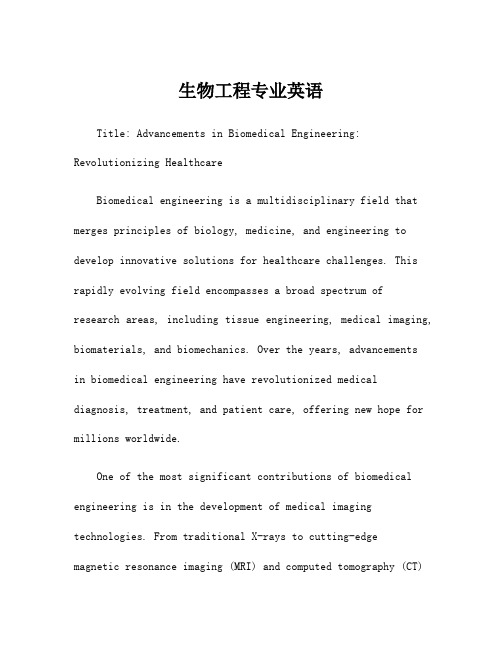
生物工程专业英语Title: Advancements in Biomedical Engineering: Revolutionizing HealthcareBiomedical engineering is a multidisciplinary field that merges principles of biology, medicine, and engineering to develop innovative solutions for healthcare challenges. This rapidly evolving field encompasses a broad spectrum of research areas, including tissue engineering, medical imaging, biomaterials, and biomechanics. Over the years, advancementsin biomedical engineering have revolutionized medical diagnosis, treatment, and patient care, offering new hope for millions worldwide.One of the most significant contributions of biomedical engineering is in the development of medical imaging technologies. From traditional X-rays to cutting-edgemagnetic resonance imaging (MRI) and computed tomography (CT)scans, these imaging modalities enable healthcareprofessionals to visualize internal structures of the human body with unprecedented clarity. Moreover, recent advancements in functional imaging techniques, such aspositron emission tomography (PET) and functional MRI (fMRI), have revolutionized our understanding of brain function and neurological disorders.In the realm of regenerative medicine, biomedical engineers are pioneering the development of tissueengineering techniques to repair or replace damaged tissues and organs. By combining scaffolds, cells, and growth factors, tissue engineers are creating artificial organs and tissues that mimic the structure and function of native tissues.These engineered tissues hold immense potential for treating conditions ranging from organ failure to severe burns,offering a promising alternative to traditionaltransplantation methods.Biomaterials play a crucial role in biomedical engineering by providing the foundation for medical devices, implants, and drug delivery systems. Advances in biomaterial science have led to the development of biocompatible materials that interact seamlessly with the human body, reducing the risk of rejection and complications. Nanotechnology has further expanded the capabilities of biomaterials, enabling precise drug targeting, enhanced imaging contrast, and controlled release of therapeutic agents.Biomechanics is another key area of biomedical engineering focused on studying the mechanical aspects of biological systems. By applying principles of physics and engineering, biomechanists analyze the movement, forces, and stresses within the human body to design orthopedic implants, prosthetic limbs, and assistive devices. These innovations improve mobility and quality of life for individuals withmusculoskeletal injuries or disabilities, enabling them to lead more active and independent lives.In addition to these areas, biomedical engineering encompasses a wide range of specialties, including medical robotics, bioinformatics, and personalized medicine.Robotics-assisted surgeries, powered exoskeletons, and wearable health monitoring devices are just a few examples of how technology is transforming healthcare delivery andpatient outcomes. Furthermore, advances in computational biology and bioinformatics are driving breakthroughs in genomics, proteomics, and drug discovery, paving the way for personalized therapies tailored to individual patients.Looking ahead, the future of biomedical engineering holds even greater promise, fueled by ongoing research and collaboration across disciplines. Emerging technologies such as 3D bioprinting, gene editing, and artificial intelligence are poised to revolutionize healthcare in ways we have yet toimagine. By harnessing the power of innovation and ingenuity, biomedical engineers will continue to push the boundaries of what is possible, ushering in a new era of personalized medicine and improved global health outcomes.In conclusion, biomedical engineering is at the forefront of transforming healthcare through innovation and technology. From medical imaging and tissue engineering to biomaterials and biomechanics, this interdisciplinary field is driving advancements that benefit patients worldwide. As we continue to unlock the mysteries of the human body and develop novel therapies, biomedical engineering will play a pivotal role in shaping the future of medicine and improving quality of life for generations to come.。
生物工程专业英语单词

生物工程专业英语单词嗜常温的Mesophilic 生源说Biogenesis 氢hydrogen 需氧的Aerobic 疫苗vaccine 碳carbon 厌氧的Anaerobic 培养cultivation 氮nitrogen 内生孢子Endospore 无菌的aseptic 氧oxygen 耐高渗Halotolerant 毒力virulence 氯chlorine 病原微生物pathogen 稀释attenuation 钠sodium 肠道的entero 消毒sterilization 分裂fission DNA Deoxyribonucleic acid RNA Ribonucleic acid 硫酸Sulfuric acid TCA Tricarboxylic acid PCR Polymerase chain reaction cfu Colony forming unit 黑曲霉Aspergillus niger 沙门氏菌Salmonella typhi大肠杆菌Escherichia coli 巴氏杀菌pesteurization HIV human immunodeficiency virus 革兰氏阳/阴性Gram positive/negative 试管Tube 烧杯Beaker 鞭毛flagella 漏斗Funnel 属genus 纤毛pili 培养皿Petri dishes 命名法nomenclature 荚膜capsule 移液枪Pipette 球菌coccus 细胞膜plasma membrane 枪头Tip 链球菌streptoccus 原生质体cytoplasm 微生物Microbe(s) 杆菌bacillus 细胞壁cell wall Microorganism 弧菌vibrio 染色体chromosome 肉眼Unaided eye 螺旋杆菌spirillum 核糖体ribosome生态系统ecosystem 新陈代谢metabolism 叶绿体chloroplast相互作用interaction 三联密码triplet 酿brewing子核苷酸碱基nucleotide bases 内质网endoplasmic reticulumA Adenine 氨基酸amino acid 杂种muleT Thymine 简并性degenerate 小麦wheatG Guanine 调控regulate 大麦barleyC Cytocine 神经元neuron 玉米maze/cornU Uracil 成纤维细fibroblast 大豆soybean胞链strand 肌肉细胞muscle cell 高粱sorghum 定位orientation 源于;得自derive 谷物cereal 引物primer 表明;指出indicate 豆类legume 互补complementary 分离isolate 穗panicle 序列sequence 扩增amplification 生理盐水saline 单倍体hyploid 载体vector 胆固醇chloesterol 双倍体diploid 质粒plasmid 白灵药panacea 常染色体autosomal chromosomes 性染色体sex chromosome 红细胞red blood cell 生殖细胞germ cell端粒telomere 转化transformatio插入addingn精子sperm 提取extract 敲除removing 卵子egg 组织tissue 克隆clone 基因组genome 器官organ 花粉pollencDNA complementary DNA 探针probe 干预intervention 生物技术biotechnology 纯化purify 症状indication 生物学的biological 重组recombinant 前体物precursor 裂解性噬菌体lytic cycle 机制,机理mechanism 膳食纤维dietary fiberbiodiversity 溶源性噬菌体lysogenic cycle 传统的conventional 生物多样性衣壳capsid 合成,混合compound 耕种tillage 成熟maturation 标识,标签label 造假adulteration 基因差异表达differential gene expression 副作用adverse/side effect 计划生育birth control 水土流失soil erosion 胚胎embryo 改善,改良amelioration 过敏原allergen非天然添加剂artificial ingredient 液态深层发酵罐submerged fermentor 饮料beverage 接种inoculation 麦汁wort 啤酒花hop 不足的deficient 探针probe 酸acid 碱alkali 糖化mashing液态发酵LSF liquid-state fermentation 固态发酵SSF solid-state fermentation 生物反应器fermentorbioreactor作业甘油三酯triglycerides 乳糖lactose 希拉细胞Hela cellmRNA messengerRNA 蔗糖sucrose 蛋白质protein rRNA ribosomal RNA 核糖ribose 糖sugar tRNA transferRNA 酶enzyme 溶酶体lysosome R基R-Group 细胞核nucleus 生物体organism 胰腺pancreas 小分子micromolecule 专业的;特化specialized 有机物organic 大分子macromolecule 细胞器organelle 细胞cell 细胞学cytology 合成synthesis 组织tissue 亲水的hydrophilic 子单位subunit 器官organ 疏水的hydrophobic 基团group 多糖polysaccharide 聚合物polymer 羧基carboxyl 缠绕intertwine 分子molecule 调节,控制regulate 细胞的cellular 功能function 细胞系cell line 脂质lipid 二糖disaccharide 由...组成compose of 葡萄糖glucose 半乳糖galactose 果糖fructose分泌secrete 碳水化合物carbohydrate 消化液digestivefluids上皮的epithelial 转换conversion 指令instruction 折叠fold 多肽polypeptide 催化catalyze 核苷,核苷酸nucleotide 围绕enclose。
生物工程专业英语1

加在外来词根的名词上,构成形容词specific特异 的,magnetic磁性的,aerobic需氧的,pubic耻骨的,oxytocic 催产的,催产剂,therapeutic治疗的,dramatic戏剧性的,
11,-ish加在颜色的形容词上,表示略带...色reddish带红色 的,微红的,yellowish带黄色的,
(1)英汉互译的几条基本原则和技巧如:
选词(Diction) 转换(Conversion) 增补(Amplification) 省略(Omission) 重复(Repetition) 替代(Substitution) 变换(Variation) 浓缩(Condensation) 拆离(Division) 缀合(Combination) 阐释(Annotation) 倒置(Inversion)
五 戊糖 戊烷 五倍的 戊糖
五邻粒 六
已糖 六足动物 昆虫纲 六聚体 七
庚烷 庚糖 七珠蛋白
8. Oct octpus octane octase
9. enne,nona nonapeptide enneahedron
10.deca,deka decapod decahedron decagram
(O. Jesperson) 他行进的速度快的令人惊讶。 他行进速度之快,令人惊讶。 他的快速行进使我们感到惊讶。 我们对他的快速行进感到惊讶。
他爸爸常常给他一些书。 His father often giv。 I gave him a book.
他已给我两本书。 He has given me two books.
tetracycline
四环素
5. pent,penta,quique pentose pentane quintuple pentose pentomer
生物工程专业英语
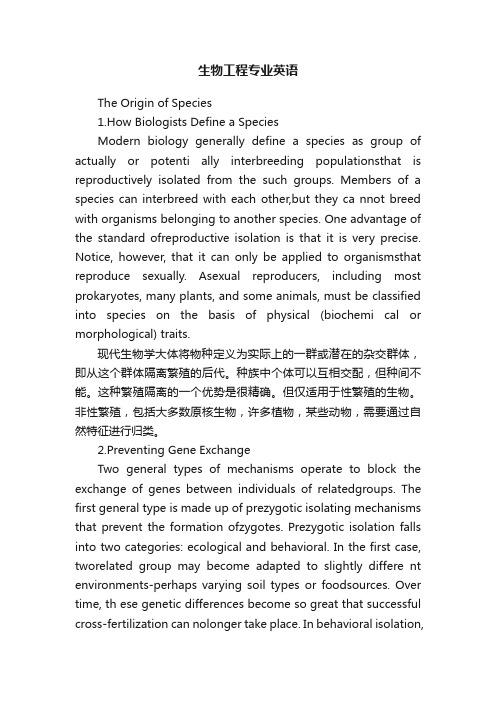
生物工程专业英语The Origin of Species1.How Biologists Define a SpeciesModern biology generally define a species as group of actually or potenti ally interbreeding populationsthat is reproductively isolated from the such groups. Members of a species can interbreed with each other,but they ca nnot breed with organisms belonging to another species. One advantage of the standard ofreproductive isolation is that it is very precise. Notice, however, that it can only be applied to organismsthat reproduce sexually. Asexual reproducers, including most prokaryotes, many plants, and some animals, must be classified into species on the basis of physical (biochemi cal or morphological) traits.现代生物学大体将物种定义为实际上的一群或潜在的杂交群体,即从这个群体隔离繁殖的后代。
种族中个体可以互相交配,但种间不能。
这种繁殖隔离的一个优势是很精确。
但仅适用于性繁殖的生物。
非性繁殖,包括大多数原核生物,许多植物,某些动物,需要通过自然特征进行归类。
2.Preventing Gene ExchangeTwo general types of mechanisms operate to block the exchange of genes between individuals of relatedgroups. The first general type is made up of prezygotic isolating mechanisms that prevent the formation ofzygotes. Prezygotic isolation falls into two categories: ecological and behavioral. In the first case, tworelated group may become adapted to slightly differe nt environments-perhaps varying soil types or foodsources. Over time, th ese genetic differences become so great that successful cross-fertilization can nolonger take place. In behavioral isolation,related groups evolve differing behaviors such as specificmating rituals-that restrict the exchange of genes to members of the same group.两种基因型机制阻碍了相关群体中个体的基因交换。
生物工程专业英语整理
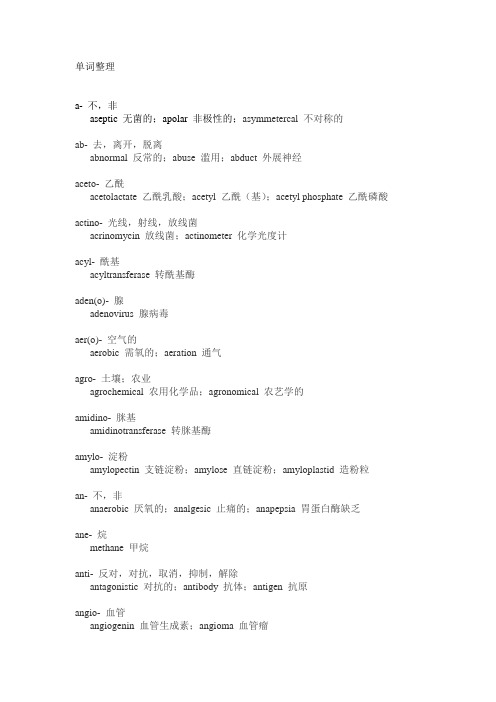
单词整理a- 不,非aseptic 无菌的;apolar 非极性的;asymmetercal 不对称的ab- 去,离开,脱离abnormal 反常的;abuse 滥用;abduct 外展神经aceto- 乙酰acetolactate 乙酰乳酸;acetyl 乙酰(基);acetyl phosphate 乙酰磷酸actino- 光线,射线,放线菌acrinomycin 放线菌;actinometer 化学光度计acyl- 酰基acyltransferase 转酰基酶aden(o)- 腺adenovirus 腺病毒aer(o)- 空气的aerobic 需氧的;aeration 通气agro- 土壤;农业agrochemical 农用化学品;agronomical 农艺学的amidino- 脒基amidinotransferase 转脒基酶amylo- 淀粉amylopectin 支链淀粉;amylose 直链淀粉;amyloplastid 造粉粒an- 不,非anaerobic 厌氧的;analgesic 止痛的;anapepsia 胃蛋白酶缺乏ane- 烷methane 甲烷anti- 反对,对抗,取消,抑制,解除antagonistic 对抗的;antibody 抗体;antigen 抗原angio- 血管angiogenin 血管生成素;angioma 血管瘤aut(o)- 自己的,自动的autotroptic 自养的;autonomous 自发的;autosensitization 自身致敏bio- 生物的biochemistry 生物化学;bioamine 生物胺;biocatalyst 生物催化剂bromo- 溴的5-bromouracil 5-溴尿嘧啶bis- 双,二bisexualism 雌雄异体;bisphenols 双酚类brady- 缓慢hradycardia 心动过缓;bradykinin 缓激肽carb(o)- 碳的carbodiimide 碳二亚胺;carbohydrate 碳水化合物carboxy(l) 羧基carboxy methylcellulose 羧甲基纤维素carcin(o)- 癌carcinogen 致癌物cardio- 心脏cardiotonic 强心的cent(i)- 一百的,百分之一的,厘century 世纪;centimeter 厘米;centimorgan 厘摩chemo- 化学chemoautotrophy 化能自养;chemosynthesis 化能合成;chemoattractant 化学引诱物chlor- 氯,绿chloramphenicol 氯霉素;chlorobenzene 氯苯;chloroplast 叶绿体chrom(o)- (chromat(o)-) 颜色chromatid 染色单体;chromosome 染色体;chromatography 色谱法cis- 顺cistrion 顺反子;cis regulation 顺式调节;cis-isomer 顺式异构体co- 一起,共同cooperate 合作;coincide 重合;cognate 同源的con- (col-,com-,cor-)连同,一起complexant 络合剂;concentrate 集中;combine 结合contra- 反对,相反contrast 对照;contrary 相反的;contrasuppression 反抑制counter- 反,逆couner-circulation 逆向循环;counter-ecolution 逆进化;counter receptor 反受体cryo- 寒冷,冷冻cryopreservation 冷冻保藏;cryogen 冷冻剂;cryophile 适寒性cyano- 青,蓝,氰cyanobacteria 蓝细菌;cyanocobalamin 氰钴胺素;cyanogen bromide 溴化氰de- 否定,除去,离开,降低,脱debug 排除故障;deceleration 降速;degeneration 退化deca- 十,葵decahedron 十面体;decane 葵烷;decamer 十聚体deoxy- 脱氧deoxycytosine 脱氧胞嘧啶di- 二,二倍,二重diploid 二倍体;dimer 二聚体;divinylbenzene 二乙烯苯dia- 横穿diameter 直径;dialysis 透析;diaphragm 隔膜dis- 否定,分离disintegration 破碎;disagree 不同意;dissemination 散播dodeca- 十二dodecahedron十二面体;dodecane 十二烷;dodecamer 十二聚体eco- 生态,居处,宿主ecogentics 生态遗传学;ecology 生态学;ecomone 生态信息素ectoblast 外胚层;ectohormone 外激素;ectodomain 胞外结构electr(o)- 电electrodialysis 电渗析en-(em-) 使成为,置于……中enable 能够;encode 编码;embed 包埋end(o)- 内endergonic 吸能的;endospore 内生孢子enol 烯醇phosphoenolpyruvate 磷酸烯醇丙酮酸enter(o)- 肠enteroacteria 肠细菌;enterobactin 肠杆菌素;enterocyte 肠细胞epi- 表;变化epichlorohydrin 表氯醇;epimerase 差向异构体酶;epithelial cell 上皮细胞erythr(o)- 红,赤erythrose 赤藓糖;erythromycin 红霉素;erythrocyte 红细胞eu- 真正eukaryote 真核生物;eukaryocyte 真核细胞;eubacteria 真细菌e(x)- 向外,超出,完全,彻底explant 外植体;elongate 拉长;evaluate 评价ex(o)- 外,在外,产生exothermic 放热的;exergonic 放能的;exogenous gene 外源基因extra- 超出extracellular 胞外的;extract 抽提物;extracellular virus 胞外病毒ferri- 高铁ferricytochrome 高铁细胞色素;ferritin 铁蛋白;ferridoxin 铁氧还原蛋白ferro- 亚铁ferrocytochrome 亚铁细胞色素;ferroheme 血红素;ferrochelatase 亚铁螯合酶flavanol 黄烷酮;flavin 黄素;flavone 黄酮fluoro- 氟基,氟代,荧光fluorochrome 荧光染料;fluoroacetate 氟乙酸;fluorometer 荧光剂formyl- 甲酰formyltetrahydrofolate 甲酰四氢叶酸;formyl 甲酰基;formylation 甲酰化geo 土地geographical barrier 地理障碍;geographical isolation 地理隔离;geosmin 土腥味素glyc(o)- 糖glycoprotein 糖蛋白hem(o,a)-,haem(o,a)-,haemat(o)-血的hemoglobin 血红蛋白;haemagglutinin 血凝素;haem 血红素hemi- 半hemicellulase 半纤维素;hemizygote 半合子;hemiacetal 半缩醛heter(o)- 异,杂,异种heterogeneous 异质的,不均一的;heterotrophic 异养的;heteroantigen 异种抗原hepato- 肝hepatocarcinoma 肝癌;hepatocyte 肝细胞;hepatotoxin 肝脏毒素homeo- 同源,同祖homeotic gene 同源异形基因hom(o)- 相同homogeneous 同质的,均一的;homologous 同源的;homoeosis 同源异形hydr(o)- 水,液体,氢hydrocarbon 烃;hydrocolloid 水胶体;hydrobios 水生生物hydroxy(l) 羟基hydroxyapatite 羟磷灰石;hydroxylase 羟化酶hyper- 超出,过度hyperfiltration 反渗透;hypertension 高血压hypo- 低,(过)少sodium hypochlorite 次氯酸钠;hypoblast 下胚层;hypoimmunity 低免疫性imino- 亚胺基iminodiacetic acid 亚胺基二乙酸immuno- 免疫immunogenic 致免疫的;immunoassay 免疫分析in-(il-,im-,ir-)不,无;在内,入内insoluble 不能溶解的;insuperable 不能克服的;impermeable 不能渗透的infra- 下面,内部infrastructure 基础结构;infrared 红外线的inter- 相互,在……之间interact 相互作用;intergeneric 属间的;inter-particle 颗粒间的intra- 在内,向内intraspecific 种内的;intra-particle 颗粒内的;intravenous 进入静脉的iodo- 碘基,碘代iodometry 碘量法;iodouracil 碘尿嘧啶;iodoacetic acid 碘乙酸iso- 同,等,异isomer 同分异构体;isomerase 异构酶;isobutyl 异丁基kary(o)- 核,细胞核karyology 胞核学keto- 酮基ketohexulose 酮己酮糖;keto acid 酮酸;ketoamin 酮胺lacto- 乳lactobacillus 乳杆菌属;lactogen 催乳素;lactoglobulin 乳球蛋白leuco- 白,无色的leucocyte 白细胞lipo- 脂lipoprotein 脂蛋白;lipoxygenase 脂氧合酶lympho- 淋巴lymphocyte 淋巴细胞macro- 大的,宏观的macromolecule 大分子;macroporous 大孔的mal- 不当,不良malabsorption 吸收不良;malassimulation 同化不全;malnutrition 营养不良megal(o)- 巨大cytomegalovirus 巨细胞病毒mercapto- 巯基β-mercaptoethylamine β-巯基乙胺meso- 内消旋;中(间)meso inositol 内消旋肌醇;mesophilic 嗜温的meth- 甲基methacrylate 甲基丙烯酸methyl 甲基methyltroph 甲基营养菌micro- 微,微小的microscope 显微镜;microcarrier 微载体;microbe 微生物mono- 一,单,单一monoclonal 单克隆的;monolayer 单层multi- 多,多方面multistage 多级;multicellularity 多细胞性;myco- 真菌mycolytic 溶真菌的;mycotoxin 真菌毒素;mycoprotein 真菌蛋白myelo- 髓鞘,髓myeloblast 成髓细胞;myelocyte 髓细胞;myeloma 骨髓瘤myo- 肌myoalbumin 肌白蛋白;myoblast 成肌细胞;myocyte 肌细胞nano- 纳nanobacteria 微小细菌;nanosecond 纳秒;nanotechnology 纳米技术neo- 新neocarcinostatin 新制癌菌素;neocerebellum 新小脑;neomycin 新霉素neur(o)- 神经neural 神经的;neurotoxin 神经毒素nitro- 硝基nitrofuran 硝基呋喃;nitroalkane 硝基烷;nitrobacteria 硝化细菌nucle(o)- 核nucleoside 核苷;nucleophilic 亲核的non- 非,无,不non-newtonian fluid 非牛顿型流体;non-aqueous solution 非水溶液nor- 去甲,正noradrenalin 去甲肾上腺素;normal 正常,正交;normocyte 正红细胞over- 在上面,超过,过overshooting 过调节;overview 简明概述;overcooled 过冷的oligo- 寡oligosaccharide 寡糖,低聚糖onco- 肿瘤oncogene 致癌基因ovo- 卵ovocenter 卵中心体;ovorubin 卵红蛋白;ovum 卵细胞oxalo- 草酰,乙二酸-酰基oxalo acetate 草酰乙酸oxy- 氧;羟基deoxyguanosine 脱氧鸟苷;oxytetracycline 土霉素;oxyproline 羟脯氨酸path(o)- 病pathogen 病原菌para- 旁(位),对(位),副parabronchus 复支气管;parathyroid gland 甲状旁腺;paraoxon 对氧磷peri- 周,周围perimeter 周长;periplasmic space 周质间隙;periblast 胚周区per- 过peroxisome 过氧化质体phenyl 苯基phenylalanine 苯丙氨酸phospho- 磷酸基phosphofructokinase 磷酸果糖激酶phosphoryl- 磷酰基phosphorylation 磷酸化作用phyto- 植物phytoalexin 植物抗毒素;phytology 植物学;phytoplankton 浮游植物plasm(o)- 原生质,血浆plasmolemma 质膜pleio- 多pleiotropic 多效的;pleioxeny 多主寄生;pleiotropy 多效性poly- 多,聚polysaccharide 多糖;polystyrene 聚苯乙烯;polyacid 多酸post- 后post-transcriptional modification 转录后修饰作用;post-exponential growth phase 后对数生长期pre- 前,在前premature 过早的;precursor 前体;premise 前提pro- 原,前prokaryote 原核生物;prostate 前列腺proteo- 蛋白proteolipid 蛋白脂质;proteome 蛋白质组;proteolysis 蛋白酶解proto- 原始,初prototype 原型;protoplast 原生质体pseud(o)- 假的pseudo-plastic fluid 假塑性流体;psudodominance 假显性;pseudohypha 假菌丝pyro- 焦,火,热pyrophosphorylase 焦磷酸化酶;pyrogen 热源;progenic exotoxin 热源性外毒素quasi- 类似,准quasi-homogeneous 准均匀的radio- 辐射,放射autoradiography 放射自显影;radiotracer 放射性示踪物;radiology 放射学re- 再,重新,反复recirculation 循环;reversion 回复;reactivity 反应性retro- 后,向后,回复retrovirus 逆转录病毒ribo- 核糖riboflavin 核黄素;ribonucleic acid 核糖核酸;ribonucleotide 核糖核苷酸self- 自身的self-fertilization 自体受精semi- 半,部分semi-permeable membrane 半透膜;semi-synthetic 半合成的;semiconservative replication 半保留复制sero- 血清serological 血清学;seroconversion 血清转变soma- 体soma 体质,胞体;somatic cell 体细胞;somatization 体部分化somato- 生长somatocrinin 生长素释放肽;somatotroph 促生长素细胞;somatotropin 促生长素,生长激素sub- 下面,次于,近于subcellular 亚细胞的;subunit 亚基;subdivide 再分super- 上,上面,超,超级superior 上面的;supernatant 上清液的syn-(sym-) 共同,合synchronize 同步;symbiosis 共生现象;synergistic 协同作用的techn(o)- 技术,工艺technology 技术(学),工艺学;technique 技术therm(o)- 热thermistor 热敏电阻;themometer 温度计thi(o)- 硫,硫代thiamine 硫胺素;thioacylation 硫代酰化;thiokinase 硫激酶thym(o)- 胸腺thymosin 胸腺素toti- 全,全部,整个totipotency 全能性trans- 横穿,通过,转移transformation 转化;transcribe 转录;transposen 转位子tri- 三,三次,三级triplet 三联体;triangle 三角形;triacylglycerol 三酰甘油ultra- 超,极端,过分ultrasonic 超声波;ultracentrifugation 超离心un- 不,相反,出去unfold 展开under- 下面,低于,不足undergraduate 大学本科生;underpin 加固……的基础uni- 单,一,同一uninucleate 单核的;unique 独一无二的up- 向上,在上upstream 上游;upright 直立的uro- 尿urokinase 尿激酶vinyl- 乙烯基polyvinylchloride 聚氯乙烯后缀:-able(-ible) 可能的practicable 可行的;responsible 负责的-ability 能力acceptability 可接受性;permeability 渗透性-age 表示动作过程、量spillage 溢出;percentage 百分比-al 接在名词后形成形容词,接在动词后形成名词personal 个人的;exceptional 例外的;refusal 拒绝-aldehyde 醛glutaraldehyde 戊二醛-amin 胺methylamine 甲胺-ane 烷methane 甲烷-ant 动作者inactivant 失活剂;bioprotectant 生物保护剂-ase 酶protease 蛋白酶;polymerase 聚合酶-ate 盐,酯phosphate 磷酸盐;sebacate 奎二酸酯-cide 杀害,消灭suicide 自杀;bactericide 杀菌剂;amoebicide 抗阿米巴药-cyte 细胞leucocyte 白细胞-derm 皮,皮层blastoderm 胚层;dermadrone 内病性皮疹-ene 烯ethylene 乙烯-(e)ry 场所;一类事物bakery 面包房;circuitry 电路系统;poultry 家禽-fold 倍twofold 两倍-(i)fy 接名词或形容词后构成动词solidify 固化;simplify 简化-gen 原,剂antigen 抗原;mutagen 诱变剂;carcinogenic 致癌的-gram 图形;记录的东西chromatogram 色谱图;polarograph 极谱图-graphy 描绘、记录的方式、学科chromatography 色层分离法;autoradiography 放射自显影术-ic anhydride 酸酐sodium chloride 氯化钠-imine 亚胺iminodiacetic acid 亚胺基二乙胺-ish 略带一点的greyish 浅灰色的-ist ……的实行者,……专业人员(专家)scientist 科学家;geneticist 遗传学家-itis 炎,发炎hepatitis 肝炎;encephalitis 脑炎-ize(-ise) 使成为atomize 雾化;oxidize 使氧化-lactone 内酯β-propiolactone β-丙醇酸内酯-lemma 皮,壳,鞘膜basilemma 基底膜;lemmatoxin 鞘毒素-less 无,不,不能stainless 不锈的-like 如……样的sponge-like 海绵状的-(o)logy(-ological,形容词)学科biology 生物学;technology 技术学,工艺学;toxicology 毒理学的-lysis 分解作用,过程glycolysis 糖酵解作用;hydrolysis 水解作用;analysis 分析-lytic(形容词,分解的)-lyze(-lise)(动词,分解)-lysate(名词,分解液)hydrolytic 水解的;hydrolyze 水解;hydro-lysate 水解液-ment 在动词后构成名词development 发展;entrainment 夹带-meter 计,表spectormeter 发光剂;viscometer 粘度计-metric 测量的gravimetric (测定)重量的;volumetric (测定)体积的;potentiometric (测量)电位的-mycete 霉菌streptomycete 链霉菌-mycin 霉素,菌素mitomycin 丝裂霉素;actinomycin 放线菌素-nema 丝,线amphinema 偶线;chromonema 染色体;nemacicide 杀线虫剂-oid 类,似,……样、状的acidoid 似酸的;amyloid 淀粉样的;carotenoid 类胡萝卜素-ol 醇butanol 丁醇;inositol 肌醇-oma 瘤myeloma 骨髓瘤;hybridoma 杂交瘤-one 酮phenoxazinone 吩噁嗪酮-ory 构成形容词transitory 短暂的;respiratory 呼吸的;构成名词,表场所depository 储藏所-ose 糖heptose 庚糖;lactose 乳糖-oside 糖苷galactoside 半乳糖苷;cardiac glycoside 强心苷-osis 病,症;acalcicosis 缺钙症;hepatitis 肝炎-ous 构成形容词extraneous 外来的;rigorous 严格的-philic 亲……的lipophilic 亲脂性的;hydrophilic 亲水的-phobic 疏……的hydrophobic 疏水的-phoresis 移动electrophoresis 电泳-phil 亲,嗜,喜acidopil 嗜酸的;aerophil 好气的-plasm 血浆,原生质protoplasm 原生质-plast 原始细胞,(质)体,血浆centroplast 中心质体;hematoplast 成血细胞;plasmolemma 质膜-proof 耐……的flame-proof 耐火的;explosion-proof 防爆的-side 苷nucleside 核苷;glycoside 糖苷-sis 构成名词,表示作用,过程mutagenesis 诱变作用;mitosis 有丝分裂;meiosis 减速分裂-some 体,粒chromosome 染色体;idiosome 核旁体;ribosome 核糖体-stat 稳定装置chemostat 恒化器-taxis,tropism 趋向性aerotaxis 趋氧性;chemiotaxis 趋化性;lipotropism 亲脂性-tion(-ation,-ition,-sion) 构成名词instrumentation 仪表化;trypsinization 胰蛋白消化酶;adhesion 粘着-tide 甘酸,肽deoxyribotide 脱氧核苷酸;propeptide 前肽-troph ……营养生物,……营养型(-trophic 构成形容词)methanotroph 甲烷营养型;autotroph 自养生物;autotrophic 自养的-wise 接名词或形容词后构成副词batchwise 分批的;likewise 同样的。
生物工程专业英语整理
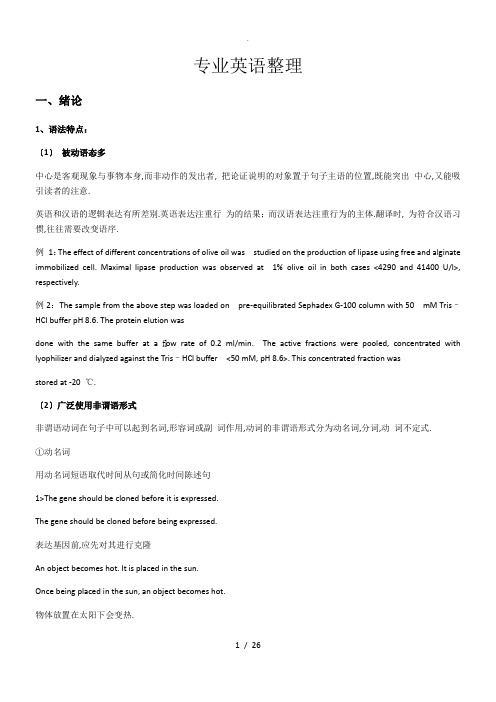
专业英语整理一、绪论1、语法特点:〔1〕被动语态多中心是客观现象与事物本身,而非动作的发出者, 把论证说明的对象置于句子主语的位置,既能突出中心,又能吸引读者的注意.英语和汉语的逻辑表达有所差别.英语表达注重行为的结果;而汉语表达注重行为的主体.翻译时, 为符合汉语习惯,往往需要改变语序.例1:The effect of different concentrations of olive oil was studied on the production of lipase using free and alginate immobilized cell. Maximal lipase production was observed at 1% olive oil in both cases <4290 and 41400 U/l>, respectively.例2:The sample from the above step was loaded on pre-equilibrated Sephadex G-100 column with 50 mM Tris–HCl buffer pH 8.6. The protein elution wasdone with the same buffer at a flow rate of 0.2 ml/min. The active fractions were pooled, concentrated with lyophilizer and dialyzed against the Tris–HCl buffer <50 mM, pH 8.6>. This concentrated fraction wasstored at -20 ℃.〔2〕广泛使用非谓语形式非谓语动词在句子中可以起到名词,形容词或副词作用,动词的非谓语形式分为动名词,分词,动词不定式.①动名词用动名词短语取代时间从句或简化时间陈述句1>The gene should be cloned before it is expressed.The gene should be cloned before being expressed.表达基因前,应先对其进行克隆An object becomes hot. It is placed in the sun.Once being placed in the sun, an object becomes hot.物体放置在太阳下会变热.We must do various experiments before a new bio-product is designed.Before designing a new bioproduct we must do variousexperiments.在设计一个新的生物制品之前,我们必须做各种实验②分词过去分词短语替代从句中的被动语态现在分词短语替代从句中的主动语态The suspension of the mixture producted in stirred tank is led by the pump to the separating device, where the unreacted residues of cellulose and lignin are separated and led into the second tank of the unreacted solid phase.③动词不定式This paper outlines some of the key issues to be addressed to achieve optimal integration either by modification of preceding <or following> chemical steps, biocatalyst evolution or combinations of these approaches together with process engineering.〔3〕省略句使用频繁<精炼>省略成分:状语从句中的主语、全部或部分谓语;定语从句中的关系代词which和that、从句中的助词等;还常用介词短语替代从句.If it is possible, the open-loop control approach shouldbe used in this system.Ifpossible,theopen-loopcontrolapproachshouldbe used in this system.可能的话,这个系统应该使用开环控制方法.其他常用的省略形式:As already discussed 前已讨论, As explained before 前已解释, As described above 如上所示, If possible <necessary>如果可能〔必要〕,If so 倘若如此,As previously mentioned 前已提到, When needed <necessary, feasible> 必要时,Where feasible 在实际可行的场合,Where possible 在可能的情况下.〔4〕It句型和祈使句使用频繁〔准确、精炼〕It句型:it 充当形式主语,避免句子"头重脚轻〞祈使句: 无主语,精炼.It is very important <possible, necessary, natural, inevitable> to…It takes very much time learning…It is clear <possible, necessary, natural, inevitable> that…It happened that …It must be admitted that…Let A be equal to B.设A等于B.Consider a high-pressure chamber. 假如有一个高气压气候室.〔5〕复杂长句使用频繁〔准确、精炼〕为了完整、准确地表达事物内在联系,使用大量从句例1:Metabolic engineering is the practice of optimizing genetic and regulatory processes within cells to increase the cells’production of a certain substance. These processes are chemical networks that use a series of biochemical reactions and enzymes that allow cells to convert raw materials into molecules necessary for the cell’s survival.〔6〕后置定语多后置定语即位于其所修饰的名词之后的定语,汉语常用前置定语或多个简单句来说明某概念或术语,而专业英语则更多地使用后置定语.All radiant energies have wavelike characteristics, which are analogous to those of waves moving through water.All radiant energies have wavelike characteristics analogous tothose of waves moving through water.所有的辐射能都具有波的特性,与水中移动的波的特征相似.2、修辞特点:(1)广泛使用一般现在时(2)较多地使用图、表和公式(3)逻辑语法使用多although, because, but, if, once, only, suppose, as a result, because of, due to, so, therefore, thus, without等.3、词汇特点:(1)词汇构成:合成法〔由相互独立的两个或更多的词合成得到新词〕,派生法〔通过对词根加上各种前缀或后缀来构成新词〕二、词汇1、For thousands of years, microorganisms have been used to supply products such as bread, beer and wine. A second phase of traditional microbial biotechnology began during World War I and resulted in the development ofthe acetone-butanol and glycerol fermentations, followed by processes yielding, for example, citric acid, vitamins and antibiotics.数千年来,微生物一直被用来供应面包、啤酒和葡萄酒等产品.在第一次世界大战期间,传统微生物生物技术的第二阶段开始,导致丙酮-丁醇和甘油发酵的发展,接着是生产过程,例如柠檬酸、维生素和抗生素.2、In the early 1970s, traditional industrial microbiology was merged with molecular biology to yield more than 40 biopharmaceutical products, such as erythropoietin, human growth hormone and interferons. Today, microbiology is a major participant in global industry, especially in the pharmaceutical, food and chemical industries.在20世纪70年代早期,传统的工业微生物学与分子生物学结合,产生了40多种生物制药产品,如促红细胞生成素、人类生长激素和干扰素.今天,微生物学是全球工业的主要参与者,特别是在制药、食品和化学工业.3、Primary metabolites are the small molecules of living cells; they are intermediates or end products of the pathways of metabolism, buildingblocksforessentialmacromolecules, or are converted into coenzymes.主要代谢物是活细胞的小分子;它们是代谢途径的中间产物或最终产物,是基本大分子的基石,或转化为辅酶.4、Primary metabolites used in the food and feed industries include: alcohols <ethanol>, amino acids <monosodium glutamate, lysine, threonine, phenylalanine, tryptophan>, flavor nucleotides,初级代谢产物用于食品和饲料行业包括:醇<乙醇>,氨基酸<味精、赖氨酸、苏氨酸、苯丙氨酸、色氨酸>,味道核苷酸,5、Organic acids <acetic, propionic, succinic, fumaric, lactic>, polyols, <glycerol, mannitol, xylitol>, polysaccharides, <xanthan, gellan>, sugars <fructose, ribose, sorbose> and vitamins [biotin].有机酸<乙酸、丙酸、琥珀酸、富马酸、乳酸>、多元醇<甘油、甘露醇、木糖醇>、多糖、糖<果糖、核糖、山梨糖>、维生素<生物素>.6、Mutants During amino acid production, feedback regulation is bypassed by isolating auxotrophic mutants and partially starving them of their requirements. Another method is to produce mutants that are resistant to a toxic analog of the desired metabolite, that is, an antimetabolite. Combinations of auxotrophic and antimetabolite resistance mutations are common in primary metabolite- producing microorganisms.突变体在氨基酸生成过程中,通过分离营养缺陷突变体,部分抑制其需求,绕过反馈调节.另一种方法是产生一种突变体,这种突变体对所需要的代谢物的有毒类似物具有抵抗力,也就是一种抗代谢物.在产生初级代谢物的微生物中,常见的是营养缺陷和抗代谢物抗性突变的组合.7、Fermentation Another factor is the increase in outward permeability, whichis veryimportant in the production of L-glutamicacid, the major commercial amino acid.发酵另一个因素是向外渗透的增加,这在主要的商业氨基酸l -谷氨酸的生产中非常重要.8、Approximately 1.2 billion poundsof monosodium glutamate are made annually by fermentation usingvarious species of the genera Corynebacterium and Brevibacterium. Molar yields of glutamate from sugar are 50– 60% and broth concentrations reach over 100 g L−1.每年大约有12亿磅的谷氨酸钠是通过利用不同种类的短杆菌和棒状杆菌等细菌进行发酵制成的.从糖摩尔谷氨酸的产量50 - 60%和肉汤浓度达到超过100 g L−1.9、Glutamic acid Normally, glutamic acid overproduction would not occur because of feedback regulation. However, modification of the cell membrane can cause glutamate to be pumped out of the cell, thus allowing its biosynthesis to proceed unabated.谷氨酸正常情况下,由于反馈调节,不会发生谷氨酸过量生产.然而,对细胞膜的修饰可以使谷氨酸被泵出细胞,从而使其生物合成得以继续进行.10、This membrane alteration is intentionally effected by biotin limitation <all glutamic acid bacteria are biotin auxotrophs>, glycerol limitation of glycerol auxotrophs, oleate limitation of oleate auxotrophs, or addition of penicillin or fatty acid derivatives to exponentially growing cells. Apparently, all of these manipulations result in a phospholipid-deficient cytoplasmic membrane.这种膜的改变是由生物素的限制<所有谷氨酸的细菌都是生物素营养不良>,甘油营养缺陷,油酸营养缺陷,或加入青霉素或脂肪酸衍生物,以指数增长的细胞.显然,所有这些操作都会导致磷脂缺乏的细胞质膜.11、Lysine Most cereals are deficient inthe essential amino acid L-lysine. Lysine is a member of the aspartate family of amino acids and is produced in bacteria by a branched pathway that also produces methionine, threonine and isoleucine.赖氨酸大多数谷物都缺乏必需的l -赖氨酸.赖氨酸是天门冬氨酸家族的一员,在细菌中通过分支途径产生,也产生蛋氨酸、苏氨酸和异亮氨酸.12、This pathway is controlled very tightly in an organism such as Escherichia coli, which includes three aspartate kinases that are each regulated by a different end product.这种途径在大肠杆菌这样的生物体中受到非常严格的控制,大肠杆菌包含三种天冬氨酸激酶,每一种激酶都由不同的最终产物调控.13、Recombinant DNA technology is beginning to have a major impact on amino acid production. The major manipulation for lysine production is aimed at increasing the levels of feedback-resistant as partatekinase and dihydrodipicolinate synthase.重组DNA技术开始对氨基酸的生产产生重大影响.赖氨酸生产的主要操作是为了提高部分儿茶酸激酶和二氢吡啶合成酶的反馈抗性水平.14、FungiFilamentousfungi are widely used for the commercial productionof organic acids, for example, 1 billion pounds of citricacid are produced per year with a market value of US$1.4 billion. Citricacid is produced via the Embden-Meyerhof pathway and the first step of the tricarboxylic acid cycle;真菌丝状真菌广泛应用于有机酸的商业化生产,例如,每年生产10亿磅柠檬酸,市场价值14亿美元.柠檬酸通过糖酵解途径和三羧酸循环的第一步产生;15、the control of the process involves the inhibition of phosphofructokinase by citric acid. The commercial process uses Aspergillus niger in media deficient in iron and manganese 锰 . A high level of citric acid production is also associated with a high intracellular concentration of fructose 2,6-biphosphate, an activator of glycolysis.控制过程涉与柠檬酸对磷酸果糖激酶的抑制作用.商业流程使用黑曲霉在媒体缺乏铁和锰锰.高水平的柠檬酸生产也与细胞内高浓度的果糖2,6-二磷酸有关,它是糖酵解的激活剂.16、Other factors contributing to high citric acid production are the inhibition ofisocitrate dehydrogenase by citricacid and the low optimum pH <1.7–2.0>. Higher pH values <e.g. 3.0> lead to the production of gluconic acids, instead of citric acid.柠檬酸对异柠檬酸脱氢酶的抑制作用和对pH的抑制作用<1.7-2.0>.较高的pH值<如3.0>会产生葡萄糖酸,而不是柠檬酸.17、Alternative processes have been developed for the production of citric acid by Candida yeasts, especially from hydrocarbons. Such yeasts are able to convert n-paraffins 石蜡 to citric and isocitric acids in extremely high yields [150– 170% <w/w> of substrate used]; titers as high as 225 g L−1 have been reached.已经开发了由念珠菌生产柠檬酸的替代工艺,特别是从碳氢化合物中生产柠檬酸.这些酵母菌能够将正石蜡转化为柠檬酸和异柠檬酸的aci.DS产率[150%~170%<w/w>],效价可达225 g L−1.18、Secondary metabolites Microbially produced secondary metabolites are extremely important for health and nutrition. As a group that includes antibiotics, other medicinals, toxins, biopesticides and animal and plant growth factors, they have tremendous economic importance.次生代谢物是微生物产生的次生代谢物,对健康和营养极为重要.包括抗生素、其他药物、毒素、生物农药和安尼.MAL和植物生长因子,它们具有巨大的经济重要性.19、Secondary metabolites have no function in the growth of the producing cultures <although, in nature, they are essential for the survival of the producing organism>, are produced by certain restricted taxonomic groups of organisms and are usually formed as mixtures of closely related members of a chemical family.次级代谢物对培养物的生长没有作用<虽然在性质上,它们是生产生物体生存所必需的>,但它们是由某些限制产生的.有机体的分类群,通常是由一个化学家族的密切相关成员组成的混合物.20、Chemical Building Blocks of Cells Three major biopolymers are present in cells: proteins,composed of amino acids linked by peptide bonds; nucleic acids, composed of nucleotides linked by phosphodiester bonds; and polysaccharides , composed of monosaccharides <sugars> linked by glycosidic bonds.细胞中存在三种主要生物聚合物:蛋白质,由肽键连接的氨基酸组成;核酸,由磷酸连接的核苷酸组成.ER键;和多糖,由单糖<糖>组成,由糖苷键连接.21、Many molecules in cells contain at least one asymmetric carbon atom, which is bonded to four dissimilar atoms. Such molecules can exist as optical isomers <mirror images>, designated D and L, which have different biological activities. In biological systems, nearly all sugars are D-isomers, while nearly all amino acids are L-isomers.细胞中的许多分子中至少有一个不对称碳原子,它与四个不同的原子相连.这些分子可以光学异构体<镜像>的形式存在,指定为D和L.有不同的生物活动.在生物系统中,几乎所有的糖都是D-异构体,而几乎所有的氨基酸都是L-异构体.22、Differences in the size, shape, charge, hydrophobicity, and reactivity of the side chains of amino acids determine the chemical and structural properties of proteins.氨基酸侧链的大小、形状、电荷、疏水性和反应性的差异决定了蛋白质的化学和结构性质.23、Amino acids with hydrophobic side chains tend to cluster in the interior of proteins away from the surrounding aqueous environment; those with hydrophilic side chains usually are toward the surface.带有疏水侧链的氨基酸倾向于聚集在蛋白质内部,远离周围的水环境;那些具有亲水侧链的氨基酸通常向表面聚集.24、The bases in the nucleotides composing DNA and RNA are heterocyclic rings attached to a pentose sugar. They form two groups: the purines—adenine <A> and guanine <G>—and the pyrimidines—cytosine <C>, thymine <T>, and uracil <U>. A, G, T, and C are in DNA, and A, G, U, and C are in RNA.组成DNA和RNA的核苷酸中的碱基是附在戊糖上的杂环.它们分为两组:嘌呤-腺嘌呤<A>和鸟嘌呤<G>-和嘧啶-胞嘧啶<C>,t海明<T>和尿嘧啶<U>.A、G、T和C在DNA中,A、G、U和C在RNA中.25、Glucose and other hexoses can exist in three forms: an open-chain linear structure, a six- member <pyranose> ring, and a five-member <furanose> ring. In biological systems, the pyranose form of D-glucose predominates.葡萄糖和其他己糖可以三种形式存在:一个开链线性结构,一个六元<吡喃>环和一个五元<呋喃糖>环.在生物系统中,D-葡萄糖的吡喃形式OSE占主导地位.26、Glycosidic bonds are formed between either the αorβ anomer 端基异构体 of one sugar and a hydroxyl group on another sugar, leading to formation of disaccharides and other polysaccharides.糖苷键是在一种糖的α或β失配体端基异构体与另一种糖上的羟基之间形成的,从而形成二糖和其他多糖.27、The long hydrocarbon chain of a fatty acid may contain no carbon - carbon double bond <saturated> or one or more double bonds <unsaturated>, which bends the chain.脂肪酸的长烃链可能不含碳-碳双键<饱和>或一个或多个双键<不饱和>,使链弯曲.28、Phospholipids are amphipathic molecules with a hydrophobic tail <often two fatty acyl chains> and a hydrophilic head.磷脂是具有疏水性尾〔通常是两个脂肪酰基链〕和亲水性头的两亲性分子.29、In aqueous solution, the hydrophobic effect and van der Waals interactions organize and stabilize phospholipids into one of three structures: a micelle, liposome, or sheet-like bilayer.在水溶液中,疏水效应和X德华相互作用将磷脂组织并稳定为三种结构之一:胶束、脂质体或片状双层.30、In a phospholipid bilayer, which constitutes the basic structure of all biomembranes, fatty acyl chains in each leaflet are oriented toward one another, forming a hydrophobic core, and the polar head groups line both surfaces and directly interact with the aqueous solution.在构成双层生物膜的基本结构的磷脂双层中,每个小叶中的脂肪酰基链彼此取向,形成疏水核心,以与极性头.基团使两面成直线,并与水溶液直接相互作用.31、The αhelix, βstrand and sheet, and turn are the most prevalent elements of protein secondary structure, which is stabilized by hydrogen bonds between atoms of the peptide backbone.α螺旋、β链和片状结构是蛋白质二级结构中最普遍的元素,它们是通过肽骨架原子间的氢键来稳定蛋白质二级结构的.32、Protein tertiary structure results from hydrophobic interactions between nonpolar side groups and hydrogen bonds between polar side groups that stabilize folding of the secondary structure into a compact overall arrangement, or conformation.蛋白质三级结构是由非极性侧基间的疏水相互作用和极性侧基间的氢键作用所致,使二级结构的折叠稳定在COMP中.采取整体安排,或构象.33、Large proteins often contain distinct domains, independently folded regions of tertiary structure with characteristic structural or functional properties or both.大蛋白通常包含不同的结构域,独立折叠的三级结构区域,具有独特的结构或功能特性,或两者兼具.34、The incorporation of domains as modules in different proteins in the course of evolution has generated diversity in protein structure and function.在进化过程中,将结构域作为不同蛋白质的模块结合在一起,在蛋白质结构和功能上产生了多样性.35、Cells contain large macromolecular assemblies in which all the necessary participants in complex cellular processes <e.g., DNA, RNA, and protein synthesis; photosynthesis; signal transduction> are integrated to form molecular machines.细胞含有大的大分子集合,其中所有参与复杂细胞过程<例如dna、rna和蛋白质合成;光合作用;信号转导>的参与者都是int.形成分子机器.36、The sequence of a protein determines its three-dimensional structure, which determines its function. In short, function derives from structure; structure derives from sequence.蛋白质的序列决定了它的三维结构,这决定了它的功能.简而言之,功能来源于结构,结构来源于序列.37、Enzymes and the Chemical Work of Cells The function of nearly all proteins depends on their ability to bind other molecules <ligands>. Ligand-binding sites酶和细胞的化学功几乎所有蛋白质的功能都取决于它们与其他分子<配体>结合的能力.配体结合位点38、The function of nearly all proteins depends on their ability to bind other molecules <ligands>. Ligand-binding sites on proteins and the corresponding ligands are chemically and topologically complementary.几乎所有蛋白质的功能都依赖于它们结合其他分子<配体>的能力.蛋白和相应配体上的配体结合位点在化学和拓扑结构上是互补的.39、The affinity of a protein for a particular ligand refers to the strength of binding; its specificity refers to the preferential binding of one or a few closely related ligands.蛋白质对特定配体的亲和力是指结合的强度;它的特异性是指一个或几个密切相关的配体的优先结合.40、Enzymes are catalytic proteins that accelerate the rate of cellular reactions by lowering the activation energy and stabilizing transition- state intermediates.酶是一种催化蛋白,通过降低活化能和稳定过渡态中间体来加速细胞的反应速度.41、An enzyme active site comprises two functional parts: a substrate-binding region and a catalytic region. The amino acids composing the active site are not necessarily adjacent in the amino acid sequence but are brought into proximity in the native conformation.酶的活性位点由两个功能部分组成:底物结合区和催化区.组成活性位点的氨基酸不一定在氨基酸序列中相邻,而是在天然构象中靠近.42、From plots of reaction rate versus substrate concentration, two characteristic parameters of an enzyme can be determined: the Michaelis constant Km, a measure of the enzyme’s affinity for substrate, and the maximal velocity Vmax, a measure of its catalytic power.从反应速率与底物浓度的图中可以确定酶的两个特征参数:米克里斯常数Km,这是酶对底物亲和力的度量;最大速度Vmax,这是它的催化能力的度量.43、Enzymes in a common pathway are located within specific cell compartments and may be further associated as domains of a monomeric protein, subunits of a multimeric protein, or components of a protein complex assembled on a common scaffold.共同途径中的酶位于特定的细胞隔间内,并可能进一步与单分子蛋白、多分子蛋白的亚基或在共同支架上组装的蛋白复合物的组成部分相关.三、荧光蛋白Fluorescent proteins as tools to aid protein productionIntroduction1、Expression of recombinant proteins from a variety of host organisms is now a common practice. However, production of properly folded proteins with high yield and purity may not always be achieved.2、Issues such as folding, solubility, protein stability, transcription and translation efficiency, post-translational processing, secretion, metabolic burden and other stress responses resulting from recombGiLnant protein production,3、as well as protein purification, need to be addressed in order to obtain biologically active recombinant proteins with high purity and yield. In this regard, genetically encoded fluorescent reporters provide ample new opportunities to better tackle these issues.4、Since the demonstration of the Aequorea victoria green fluorescent protein <GFP> as a versatile reporter, several additional GFP-like fluorescent proteins with various colors have been discovered and their genes cloned.5、Synthetic fluorescent protein variants have also been developed, exhibiting traits distinct from their wild-type counterparts. The properties of selected fluorescent protein variants derived from the A. victoria GFP and the Discosomared fluorescent protein <DsRed> are summarized in Table 1.6、Fluorescence spectra of enhanced GFP variants along with DsRed are shown in Figure 1, and fluorescence of purified protein variants derived from DsRed are shown in Figure 2.7、Readers are referred to the work of Labas et al. for information of additional fluorescent proteins. These GFP-like proteins each has its own unique properties, while sharing common structural, biochemical and photophysical characteristics.8、GFP-like proteins are relatively small <25–30 kDa> and their fluorescence mechanism is self-contained, requiring no cofactors. These unique properties make GFP-like proteins very attractive tools in non-invasive biological monitoring applications.9、As a tool to improve recombinant protein production, fluorescent proteins can be used to monitor the protein product or the cellular processes relevant to recombinant protein production.10、Monitoring protein production11、Fluorescent proteins are commonly used as a reporter for a protein of interest, normally by tagging the fluorescent protein reporter to the protein of interest via genetic fusion.12、Functional fusion ofAequoreaGFP to a broad range of protein partners at either N- or C- terminus has been reported, and a direct quantitative correlation between the GFP fluorescence intensity and the titer or even the functional activity of the fusion partner can often be established.13、To minimize potential interference by the GFP tag on its fusion partner, it is desirable and sometimes necessary to incorporate a peptide linker to allow sufficient spatial separation of the two protein moieties to assure fusion protein stability and functionality.14、Flexible linkers lacking large bulky hydrophobic residues <e.g. GSAGSAAGSGEF> are commonly used, while hydrophilic helix-forming linker peptides have been reported to be superior to flexible linkers in some cases.15、To allow removal of the GFP tag, an enzymatic cleavage site <e.g. enterokinase or Factor Xa cleavage sites> can be engineered into the linker. It is preferred to splice the GFP/linker to the N-terminus of the target protein, provided such fusion does not impair the target protein function and stability.16、With the majority of the enzymes commonly used for tag removal, this fusion orientation enables elimination of the tag without leaving extraneous amino acid residues on the target protein after cleavage.17、Alternatively, chemical cleavage based on cyanogen bromide, formic acid, or hydroxylamine may be considered, provided the target proteins are not susceptible to cutting by these chemical agents.18、Further information of tag removal can be found in a comprehensive review by Hearn and Acosta. In addition to tandem fusion, insertional fusion <i.e. by inserting the protein of interest into GFP or vise versa> may also be feasible.19、Recombinant protein production can be monitored non-invasively,in situ, and almost in real time, by monitoring culture fluorescence using on-line optical sensors.20、This information is useful in determining the optimal product harvest time to avoid product degradation and to devise process control strategies to optimize culture/operating conditions to improve recombinant protein production21、GFP has also been used to monitor recombinant virus titers in cell cultures, and cell density in microbial, animal, and plant cell cultures;22、the cell growth information can be used, in turn, to optimize the culture process for improved recombinant protein production <e.g. by optimizing the feeding profiles of the limiting nutrient or the promoter inducer, or by determining the optimal product harvest time>.23、Additionally, GFP-fusion coupled with flow cytometric analysis is useful for profiling recombinant protein expression among different cell subpopulations, and selection of highproducing cells.24、Monitoring protein purification25、The fact that GFP fluorescence is readily detectable makes it a very attractive tool for optimizing purification of recombinant proteins.26、Poppenborg et al. optimized immobilized metal affinity separation of a histidine-rich protein tagged with GFP by tracking the fluorescence of the fusion protein.27、Since GFP is a highly hydrophobic protein, recovery of GFP-fusion proteins can be facilitated by using hydrophobic interaction chromatography <HIC>.28、GFP has also been engineered to allow affinity purification. Paramban et al developed a chimeric GFP tag having an internal hexahistidine sequence.29、Such a GFP tag allows efficient purification of GFP-fusion proteins based on immobilized metal affinity separation, as well as maximum flexibility for protein or peptide fusions since both termini of the GFP are available.四、翻译技巧一1、单词转化〔1〕——词义引申〔1〕词义转译〔引申转译〕如遇无法直译或不宜直译的词〔组〕,应根据上下文和逻辑关系,引申转译.Oxygen forms about one fifth of the atmosphere.氧约占大气的五分之一.〔不译为"形成〞〕When suglight falls on the leaves of plants it is transformed into chemical energy.当阳光照在植物的叶子上时,就转变成化学能〔不译"落〞〕Laser is one of the most sensational developments in recent years.激光是近年来轰动一时的科学成就之一.〔不译为"发展〞〕More weight must be placed on the past history of Patients.必须更加重视患者的病史.〔不译为"过去的历史〞This medicine acts well on the heart.这种药治疗心脏病疗效很好.〔不译"对…起作用〞This kind of wood works easily.这种木材很容易加工.〔不译为"工作〞〕The patient had been given three transfusions <输血〕after he was admitted into the hospital.病人入院后已输过三次血了.〔不译为"给〞〕(2)词义具体化翻译时,根据汉语的表达习惯,把原文中某些词义较笼统的词引申为词义较具体的词.Other things being equal, iron heats up faster than aluminium 〔铝〕.其它条件相同时,铁比铝热的快.Hard metals can be easily cut with grinding wheels.硬金属可以很容易用砂轮磨削.When we speak, sound waves begin to travel and go in all directions.我们说话时,声波就开始传播,并向四面八方扩散.(3)词义抽象化翻译时,根据汉语的表达习惯,把原文中词义较为具体的词引申为较抽象,或词义较一般的词.Steel and cast iron also differ in carbon.钢和铸铁的含碳量也不相同.〔把"碳〞抽象化为"含碳量〞〕We have progressed a long way from the early days of electrical engineering.电气工程自从出现以来,已经有了很大的发展.〔不译为"已经前进了很长一段路〞〕Rocks made under water tell another story.水下形成的岩石说明另一个问题.〔不译为"讲另一个故事〞〕(4)词的搭配要注意动词与名词,以与形容词与名词的搭配, 遇到不合乎汉语的搭配习惯时,可以把动词或形容词的词义加以引申,以适合名词.Rubber, porcelain 〔陶瓷〕and glass are commonly used to resist electric current.橡胶、陶瓷和玻璃常常用来隔绝电流.〔不译为"抵抗电流〞〕Some plants have flowers but do not seed.有些植物开花而不结果.〔不译为"有花〞〕The sun's heat offers an almost limitless sourse of power.太阳热提供了一个几乎取之不尽的动力源泉.〔不译为"无限的动力源泉〞〕Americans every year swallow 15,000 tons of aspirin, one of the safest and most effective drugs invented by man.阿司匹林是人类发明的最安全、最有效的药物,美国每年要消耗15000吨.〔不译为"吞咽〞〕Alloys belong to a half-way house between mixtures and compounds.合金是介于混合物和化合物之间的一种中间结构.〔不翻译为"两地间中途歇脚的客栈〞〕Industrialization and environmental degradation seem to go hand in hand.工业化发展似乎伴随着环境的退化.〔不译为"携手〞〕In the microbial transformation of contaminants,organisms can either "eat〞the toxins or break them dow in the process of consuming other substances.在对污染物进行微生物转化的过程中,生物会清除毒素或在消耗其他物质时把这些毒素分解.〔吃掉〕The plan for launching the man-made satellite still lieson the table.那项发射人造卫星的计划仍被搁置,无法执行.〔放在桌子上〕The furnace eats up fuel at the rate of three tons per hour.炉子以每小时三吨的速度消耗燃料.〔吃光〕例题:试译下列各句,注意对划线词的词义作专业化引申:Rubber is not hard, it gives way to pressure.橡胶性软,受压变形.For millions of people suffering from arthritis <关节炎>, it is the only thing that works.对于千百万关节炎患者来说,这是惟一奏效的药物.Porcelain is commonly used to resist electric current.陶瓷常用来隔绝电流.Zinc is easy to obtain from its ore.锌容易从锌矿中提炼.There are three things we have to know about every force in order to be able to understand the effect it produced.要了解力的作用,我们必须懂得力的三要素.The purpose of a driller is to cut holes.钻床的功能是钻孔.The energy is so small that something must be done to prevent the complete loss of signal.由于能量太小,必须采取措施以防止信号完全丢失.The foresight <远见> and coverage shown by the inventor of the process aremost commendable〔值得称赞的〕.这种方法的发明者所表现的远见卓识和渊博知识,给人以良好的印象.The book is perhaps too high-powered for technician in general.这本书对一般技术员来说也许内容太深.The expense of such an instrument has discouraged its use.这种仪器很昂贵,使其应用受到限制.2、单词转化〔2〕——词类转换〔1〕非谓语译为汉语中的动词一个汉语的句子往往可以同时使用好几个动词, 而英语的句子一般只用一个谓语动词,其它的动词就得变成非谓语形式.例如:There are several types of mechanisms used for controlling the speed of a drilling machine.有几种机械可以用来控制钻床的转速.(2)名词译为汉语中的动词一般来源于动词名词化结构.Determination of FCC was conducted with flux data only.仅由流量数据确定FCC.。
生物工程专业英语复习总结
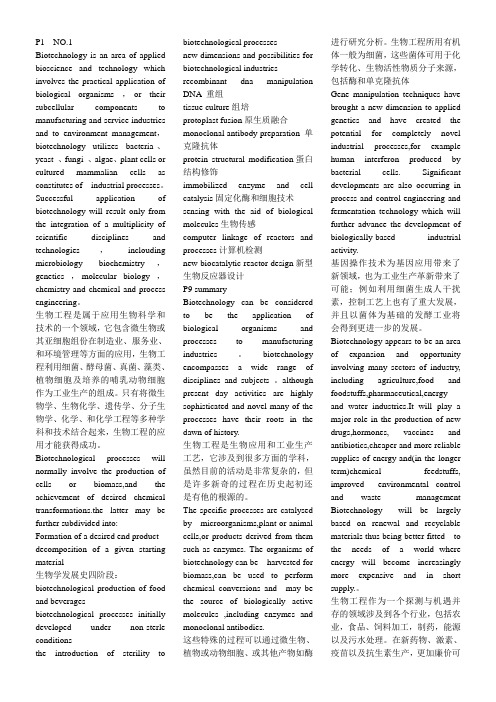
P1 NO.1Biotechnology is an area of applied bioscience and technology which involves the practical application of biological organisms ,or their subcellular components to manufacturing and service industries and to environment management,biotechnology utilizes bacteria、yeast 、fungi 、algae、plant cells or cultured mammalian cells as constitutes of industrial processes。
Successful application of biotechnology will result only from the integration of a multiplicity of scientific disciplines and technologies,inclouding microbiology biochemistry,genetics ,molecular biology ,chemistry and chemical and process engineering。
生物工程是属于应用生物科学和技术的一个领域,它包含微生物或其亚细胞组份在制造业、服务业、和环境管理等方面的应用,生物工程利用细菌、酵母菌、真菌、藻类、植物细胞及培养的哺乳动物细胞作为工业生产的组成。
只有将微生物学、生物化学、遗传学、分子生物学、化学、和化学工程等多种学科和技术结合起来,生物工程的应用才能获得成功。
Biotechnological processes will normally involve the production of cells or biomass,and the achievement of desired chemical transformations.the latter may be further subdivided into:Formation of a desired end product decomposition of a given starting material生物学发展史四阶段:biotechnological production of food and beveragesbiotechnological processes initially developed under non-sterle conditionsthe introduction of sterility to biotechnological processesnew dimensions and possibilities forbiotechnological industriesrecombinant dna manipulationDNA重组tissue culture组培protoplast fusion原生质融合monoclonal antibody preparation 单克隆抗体protein structural modification蛋白结构修饰immobilized enzyme and cellcatalysis固定化酶和细胞技术sensing with the aid of biologicalmolecules生物传感computer linkage of reactors andprocesses计算机检测new biocatalytic reactor design新型生物反应器设计P9 summaryBiotechnology can be consideredto be the application ofbiological organisms andprocesses to manufacturingindustries 。
- 1、下载文档前请自行甄别文档内容的完整性,平台不提供额外的编辑、内容补充、找答案等附加服务。
- 2、"仅部分预览"的文档,不可在线预览部分如存在完整性等问题,可反馈申请退款(可完整预览的文档不适用该条件!)。
- 3、如文档侵犯您的权益,请联系客服反馈,我们会尽快为您处理(人工客服工作时间:9:00-18:30)。
生物工程专业英语[整理版]Specialized English in BiotechnologyThis material is dedicated to studentsmajoring in Biotechnology at Hefei University.All rights reservedContentsLesson 1 What isBiotechnology? ......................................................... ....................... 3 Lesson 2 Where Did BiotechnologyBegin? ................................................................4 Lesson 3 Brief History ofBiotechnology .......................................................... .......... 7 Lesson 4 Dogma, DNA, andEnzymes ...................................................................... 10 Lesson 5 Polymerase Chain Reaction - XeroxingDNA ............................................ 12 Lesson 6 Monoclonal AntibodyTechnology .............................................................14 Lesson 7 The Human GenomeProject ................................................................ ...... 16 Lesson 8 Whose Genome is It, Anyway?................................................................. .. 19 Lesson 9 Agriculture - AnOverview ............................................................... .......... 21 Lesson 10 Gene Gun Speeds Search for New OrchidColors .................................... 24 Lesson 11 Transforming Plants ................................................................. ................. 26 Lesson 12 Animals and AnimalHealth ................................................................. ..... 29 Lesson 13Biomining .............................................................. ................................... 31 Lesson 14Biofuel ................................................................ ...................................... 32 Lesson 15 New Foods and Food Producers ...............................................................34 Lesson 16 Blazing a Genetic Trail inMedicine (37)Readingmaterials .............................................................. . (39)Lesson 1 What is Biotechnology?Biotechnology in one form or another has flourished sinceprehistoric times. When the first human beings realized that they could plant their own crops and breed their own animals, they learned to use biotechnology. The discovery that fruit juices fermented into wine, or that milk could be converted into cheese or yogurt, or that beer could be made by fermenting solutions of malt and hops began the study of biotechnology. When the first bakers found that they could make a soft, spongy bread rather than a firm, thin cracker, they were acting as fledgling biotechnologists. The first animal breeders, realizing that different physical traits could be either magnified or lost by mating appropriate pairs of animals, engaged in the manipulations of biotechnology.What then is biotechnology? The term brings to mind many different things. Some think of developing new types of animals. Others dream of almost unlimited sources of human therapeutic drugs. Still others envision the possibility of growing crops that are more nutritious and naturally pest-resistant to feed a rapidly growing world population. This question elicits almost as many first-thought responses as there are people to whom the question can be posed.In its purest form, the term "biotechnology" refers to the use of living organisms or their products to modify human health and the humanenvironment. Prehistoric biotechnologists did this as they used yeast cells to raise bread dough and to ferment alcoholic beverages, and bacterial cells to make cheeses and yogurts and as they bred their strong, productive animals to make even stronger and more productive offspring.Throughout human history, we have learned a great deal about the different organisms that our ancestors used so effectively. The marked increase in our understanding of these organisms and their cell products gains us the ability to control the many functions of various cells and organisms. Using the techniques of gene splicing and recombinant DNA technology, we can now actually combine the genetic elements of two or more living cells. Functioning lengths of DNA can be taken from one organism and placed into the cells of another organism. As a result, for example, we can cause bacterial cells to produce human molecules. Cows can produce more milk for the same amount of feed. And we can synthesize therapeutic molecules that have never before existed.Lesson 2 Where Did Biotechnology Begin?With the BasicsCertain practices that we would now classify as applications of biotechnology have been in use since man's earliest days. Nearly 10,000 years ago, our ancestors were producing wine, beer, and bread by using fermentation, a natural process in which the biological activity of one-celled organisms plays a critical role.In fermentation, microorganisms such as bacteria, yeasts, and molds are mixed with ingredients that provide them with food. As they digest this food, the organisms produce two critical by-products, carbondioxide gas and alcohol.In beer making, yeast cells break down starch and sugar (present in cereal grains) to form alcohol; the froth, or head, of the beer results from the carbon dioxide gas that the cells produce. In simple terms, the living cells rearrange chemical elements to form new products that they need to live and reproduce. By happy coincidence, in the process ofdoing so, they help make a popular beverage.Bread baking is also dependent on the action of yeast cells. Thebread dough contains nutrients that these cells digest for their own sustenance. The digestion process generates alcohol (which contributesto that wonderful aroma of baking bread) and carbon dioxide gas (which makes the dough rise and forms the honeycomb texture of the baked loaf).Discovery of the fermentation process allowed early peoples to produce foods by allowing live organisms to act on other ingredients.But our ancestors also found that, by manipulating the conditions under which the fermentation took place, they could improve both the quality and the yield of the ingredients themselves.Crop ImprovementAlthough plant science is a relatively modern discipline, its fundamental techniques have been applied throughout human history. When early man went through the crucial transition from nomadic hunter tosettled farmer, cultivated crops became vital for survival. These primitive farmers, although ignorant ofthe natural principles at work, found that they could increase the yield and improve the taste of crops by selecting seeds fromparticularly desirable plants.Farmers long ago noted that they could improve each succeedingyear's harvest by using seed from only the best plants of the current crop. Plants that, for example, gave the highest yield, stayed the healthiest during periods of drought or disease, or were easiest to harvest tended to produce future generations with these same characteristics. Through several years of careful seed selection, farmers could maintain and strengthen such desirable traits.The possibilities for improving plants expanded as a result of Gregor Mendel's investigations in the mid-1860s of hereditary traits in peas. Once the genetic basis of heredity was understood, the benefits of cross-breeding, or hybridization, became apparent: plants with different desirable traits could be used to cultivate a later generation that combined these characteristics.An understanding of the scientific principles behind fermentation and crop improvement practices has come only in the last hundred years. But the early, crude techniques, even without the benefit of sophisticated laboratories and automated equipment, were a true practice of biotechnology guiding natural processes to improve man's physical and economic well-being.Harnessing Microbes for HealthEvery student of chemistry knows the shape of a Buchner funnel, but they may be unaware that the distinguished German scientist it was named after made the vital discovery (in 1897) that enzymes extracted from yeast are effective in converting sugar into alcohol. Major outbreaks of disease in overcrowded industrial cities led eventually to the introduction, in the early years of the present century, of large-scale sewage purification systems based on microbial activity. By this time it had proved possible to generate certain key industrial chemicals (glycerol, acetone, and butanol) using bacteria.Another major beneficial legacy of early 20th century biotechnology was the discovery by Alexander Fleming (in 1928) of penicillin, an antibiotic derived from the mold Penicillium. Large-scale production of penicillin was achieved in the 1940s. However, the revolution in understanding the chemical basis of cell function that stemmed from the post-war emergence of molecular biology was stillto come. It was this exciting phase of bioscience that led to the recent explosive development ofbiotechnology.Lesson 3 Brief History of BiotechnologyBiotechnology seems to be leading a sudden new biological revolution. It has brought us to the brink of a world of "engineered" products that are based in the natural world rather than on chemical and industrial processes.Biotechnology has been described as "Janus-faced." This implies that there are two sides. On one, techniques allow DNA to be manipulated to move genes from one organism to another. On the other, it involves relatively new technologies whose consequences are untested and should be met with caution. The term "biotechnology" was coined in 1919 by Karl Ereky, an Hungarian engineer. At that time, the term meant all the lines of work by which products are produced from raw materials with the aid of living organisms. Ereky envisioned a biochemical age similar to the stone and iron ages.A common misconception among teachers is the thought that biotechnology includes only DNA and genetic engineering. To keep students abreast of current knowledge, teachers sometimes have emphasized the techniques of DNA science as the "end-and-all" of biotechnology. This trend has also led to a misunderstanding in the general population. Biotechnology is NOT new. Man has been manipulating living things to solve problems and improve his way of life for millennia. Early agriculture concentrated on producing food. Plants and animals were selectively bred, and microorganisms were used to make food items such as beverages, cheese, and bread.The late eighteenth century and the beginning of the nineteenth century saw the advent of vaccinations, crop rotation involving leguminous crops, and animal drawn machinery. The end of the nineteenth century was a milestone of biology. Microorganisms were discovered, Mendel's work on genetics was accomplished, and institutes forinvestigating fermentation and other microbial processes were established by Koch, Pasteur, and Lister.Biotechnology at the beginning of the twentieth century began to bring industry and agriculture together. During World War I, fermentation processes were developed that produced acetone from starch and paint solvents for the rapidly growing automobile industry. Work in the 1930s was geared toward using surplus agricultural products to supply industry instead of imports or petrochemicals. The advent of World War II brought the manufacture of penicillin. The biotechnical focus moved to pharmaceuticals.The "cold war" years were dominated by work with microorganisms in preparation for biological warfare, as well as antibiotics and fermentation processes.Biotechnology is currently being used in many areas including agriculture, bioremediation, food processing, and energy production. DNA fingerprinting is becoming a common practice in forensics. Similar techniques were used recently to identify the bones of the last Czar of Russia and several members of his family. Production of insulin and other medicines is accomplished through cloning of vectors that now carry the chosen gene. Immunoassays are used not only in medicine for drug level and pregnancy testing, but also by farmers to aid in detection of unsafe levels of pesticides, herbicides, and toxins on crops and in animal products. These assays also provide rapid fieldtests for industrial chemicals in ground water, sediment, and soil. Inagriculture, genetic engineering is being used to produce plants that are resistant to insects, weeds, and plant diseases.A current agricultural controversy involves the tomato. A recent article in the New Yorker magazine compared the discovery of the edible tomato that came about by early biotechnology with the new "Flavr-Savr" tomato brought about through modern techniques. In the very near future, you will be given the opportunity to bite into the Flavr-Savr tomato, the first food created by the use of recombinant DNA technology ever to go on sale.What will you think as you raise the tomato to your mouth? Will you hesitate? This moment may be for you as it was for Robert Gibbon Johnson in 1820 on the steps of the courthouse in Salem, New Jersey. Prior to this moment, the tomato was widely believed to be poisonous. As a large crowd watched, Johnson consumed two tomatoes and changed forever the human-tomato relationship. Since that time, man has sought to produce the supermarket tomato with that "backyard flavor." Americans also want that tomato available year-round.New biotechnological techniques have permitted scientists to manipulate desired traits. Prior to the advancement of the methods of recombinant DNA, scientists were limited to the techniques of their time - cross-pollination, selective breeding, pesticides, and herbicides. Today's biotechnology has its "roots" in chemistry, physics, andbiology . The explosion in techniques has resulted in three majorbranches of biotechnology: genetic engineering, diagnostic techniques, and cell/tissue techniques.Lesson 4 Dogma, DNA, and EnzymesThe Central DogmaThough it comes as no surprise that the composition of DNA between different organisms is different, it is not immediately obvious why the muscle cells, blood cells, and brain cells of any one particular vertebrate are so different in their structure and composition when the DNA of every one of their cells is identical. This is the key to one of the most exciting areas of modern cell biology. In different cell types, different sets of the total number of genes (genome) are expressed. In other words, different regions of the DNA are "active" in the muscle cells, blood cells, and brain cells.To understand how this difference in DNA activity can lead to differences in cell structure and composition, it is necessary to consider what is often known as the central dogma of molecular biology: "DNA makes RNA makes protein." In molecular terms, a gene is thatportion of DNA that encodes for a single protein. The dictum "one gene makes one protein" has required some modification with the discoverythat some proteins are composed of several different polypeptide chains, but the "one gene makes one polypeptide" rule does hold.DNA Contains the Blueprint for all Cell ProteinsMessenger RNA is a precise copy (transcript) of the coded sequenceof nucleic acid bases in DNA, and this message is translated into aunique protein molecule on specialist organelles (ribosomes) present in the cytoplasm of all cells. Proteins, which are largely made up of carbon (C), hydrogen (H), oxygen (0), and nitrogen (N), are constructed from 20 different, common amino acids. The versatility of proteins, the workhorse molecules of the cell, stems from the immense variety of molecular shapes that can be created by linking amino acids together in different sequences. The smaller proteins consist of only a few dozen amino acids, whereas the larger ones may contain in excess of 200 amino acids, all linked together in a linear chain by peptide bonds.As the proteins are released from the ribosome, they fold intounique shapes, under the influence of chemical forces that depend on the particular sequence of amino acids. So the protein primary sequence, encoded in the gene and faithfully transcribed and translated into an amino acid chain, determines the three-dimensional structure of the emerging molecule. The human body possesses some 30,000 different kinds of proteins and several million copies of many of these. Each plays a specific role - for example, hemoglobin carries oxygen in the blood, actin and myosin interact to generate muscle movement, and acetylcholine receptor molecules mediate chemical transmission between nerve and muscle cells.Enzymes - Protein BiocatalystsAn essential group of proteins - the enzymes - act as biological catalysts and regulate all aspects of cell metabolism. They enable breakdown of high-energy food molecules (carbohydrates) to provideenergy for biological reactions, and they control the synthetic pathways that result in the generation of lipids (e.g., fats, cholesterol, and other vital membrane components), carbohydrates (sugars, starch, and cellulose - the key components of plant cell walls), and many vital small biomolecules essential for cell function.Though grouped together for their capacity to speed up chemical reactions that would proceed only very slowly at room temperature, different classes of enzymes vary greatly in their structure and function. Most cells contain about a thousand different enzymes, each capable of catalyzing a unique chemical reaction.Lesson 5 Polymerase Chain Reaction - Xeroxing DNAWho would have thought a bacterium hanging out in a hot spring in Yellowstone National Park would spark a revolutionary new laboratory technique? The polymerase chain reaction, now widely used in research laboratories and doctor's offices, relies on the ability of DNA-copying enzymes to remain stable at high temperatures. No problem for Thermus aquaticus, the sultry bacterium from Yellowstone thatnow helps scientists produce millions of copies of a single DNA segment in a matter of hours.In nature, most organisms copy their DNA in the same way. The PCR mimics this process, only it does it in a test tube. When any cell divides, enzymes called polymerases make a copy of all the DNA in each chromosome. The first step in this process is to "unzip" the two DNAchains of the double helix. As the two strands separate, DNA polymerase makes a copy using each strand as a template.The four nucleotide bases, the building blocks of every piece of DNA, are represented by the letters A, C, G, and T, which stand for their chemical names: adenine, cytosine, guanine, and thymine. The A on one strand always pairs with the T on the other, whereas C always pairs with G. The two strands are said to be complementary to each other.To copy DNA, polymerase requires two other components: a supply ofthe four nucleotide bases and something called a primer. DNA polymerases, whether from humans, bacteria, or viruses, cannot copy a chain of DNA without a short sequence of nucleotides to "prime" the process, or getit started. So the cell has another enzyme called a primase thatactually makes the first few nucleotides of the copy. This stretch of DNA is called a primer. Once the primer is made, the polymerase can take over making the rest of the new chain.A PCR vial contains all the necessary components for DNA duplication: a piece of DNA, large quantities of the four nucleotides, largequantities of the primer sequence, and DNA polymerase. The polymerase is the Taq polymerase, named for Thermus aquaticus, from which it was isolated.The three parts of the polymerase chain reaction are carried out in the same vial, but at different temperatures. The first part of the process separates the two DNA chains in the double helix. This is donesimply by heating the vial to 90-95 degrees centigrade (about 165 degrees Fahrenheit) for 30 seconds.But the primers cannot bind to the DNA strands at such a high temperature, so the vial is cooled to 55 degrees C (about 100 degrees F). At this temperature, the primers bind or "anneal" to the ends of the DNA strands. This takes about 20 seconds.The final step of the reaction is to make a complete copy of the templates. Since the Taq polymerase works best at around 75 degrees C (the temperature of the hot springs where the bacterium was discovered), the temperature of the vial is raised.The Taq polymerase begins adding nucleotides to the primer and eventually makes a complementary copy of the template. If the template contains an A nucleotide, the enzyme adds on a T nucleotide to the primer. If the template contains a G, it adds a C to the new chain, and so on to the end of the DNA strand. This completes one PCR cycle.The three steps in the polymerase chain reaction - the separation of the strands, annealing the primer to the template, and the synthesis of new strands - take less than two minutes. Each is carried out in the same vial. At the end of a cycle, each piece of DNA in the vial has been duplicated.But the cycle can be repeated 30 or more times. Each newlysynthesized DNA piece can act as a new template, so after 30 cycles, 1 billion copies of a single piece of DNA can be produced! Taking intoaccount the time it takes to change the temperature of the reaction vial, 1 million copies can be ready in about three hours.PCR is valuable to researchers because it allows them to multiply unique regions of DNA so that they can be detected in large genomes. Researchers in the Human Genome Project are using PCR to look for markers in cloned DNA segments and to order DNA fragments in libraries.Lesson 6 Monoclonal Antibody TechnologySubstances foreign to the body, such as disease-causing bacteria, viruses and other infectious agents, known as antigens, are recognizedby the body's immune system as invaders. Our natural defenses against these infectious agents are antibodies, proteins that seek out the antigens and help destroy them.Antibodies have two very useful characteristics. First, they are extremely specific; that is, each antibody binds to and attacks one particular antigen. Second, some antibodies, once activated by the occurrence of a disease, continue to confer resistance against that disease; classic examples are the antibodies to the childhood diseases chickenpox and measles.The second characteristic of antibodies makes it possible to develop vaccines. A vaccine is a preparation of killed or weakened bacteria or viruses that, when introduced into the body, stimulates the productionof antibodies against the antigens it contains.It is the first trait of antibodies, their specificity, that makes monoclonal antibody technology so valuable. Not only can antibodies beused therapeutically, to protect against disease; they can also help to diagnose a wide variety of illnesses, and can detect the presence of drugs, viral and bacterial products, and other unusual or abnormal substances in the blood.Given such a diversity of uses for these disease-fighting substances, their production in pure quantities has long been the focus ofscientific investigation. The conventional method was to inject a laboratory animal with an antigen and then, after antibodies had been formed, collect those antibodies from the blood serum (antibody-containing blood serum is called antiserum). There are two problems with this method: It yields antiserum that contains undesired substances, and it provides a very small amount of usable antibody.Monoclonal antibody technology allows us to produce large amounts of pure antibodies in the following way: We can obtain cells that produce antibodies naturally; we also have available a class of cells that can grow continually in cell culture. If we form a hybrid that combines the characteristic of "immortality" with the ability to produce the desired substance, we would have, in effect, a factory toproduce antibodies that worked around the clock.In monoclonal antibody technology, tumor cells that can replicate endlessly are fused with mammalian cells that produce an antibody. The result of this cell fusion is a "hybridoma," which will continually produce antibodies. These antibodies are called monoclonal because they come from only one type of cell, the hybridoma cell; antibodies producedby conventional methods, on the other hand, are derived from preparations containing many kinds of cells, and hence are called polyclonal. An example of how monoclonal antibodies are derived is described below.A myeloma is a tumor of the bone marrow that can be adapted to grow permanently in cell culture. When myeloma cells were fused withantibody-producing mammalian spleen cells, it was found that the resulting hybrid cells, or hybridomas, produced large amounts of monoclonal antibody. This product of cell fusion combined the desired qualities of the two different types of cells: the ability to grow continually, and the ability to produce large amounts of pure antibody.Because selected hybrid cells produce only one specific antibody, they are more pure than the polyclonal antibodies produced by conventional techniques. They are potentially more effective than conventional drugs in fighting disease, since drugs attack not only the foreign substance but the body's own cells as well, sometimes producing undesirable side effects such as nausea and allergic reactions. Monoclonal antibodies attack the target molecule and only the target molecule, with no or greatly diminished side effects.Lesson 7 The Human Genome ProjectSince the beginning of time, people have yearned to explore the unknown, chart where they have been, and contemplate what they have found. The maps we make of these treks enable the next explorers to push ever farther the boundaries of our knowledge - about the earth, the sea,the sky, and indeed, ourselves. On a new quest to chart the innermost reaches of the human cell, scientists have now set out on biology's most important mapping expedition: the Human Genome Project.Its mission is to identify the full set of genetic instructions contained inside our cells and to read the complete text written in the language of the hereditary chemical DNA (deoxyribonucleic acid). As part of this international project, biologists, chemists, engineers, computer scientists, mathematicians, and other scientists will work together to plot out several types of biological maps that will enable researchers to find their way through the labyrinth of molecules that define the physical traits of a human being.Packed tightly into nearly every one of the several trillion body cells is a complete copy of the human "genome" - all the genes that make up the master blueprint for building a man or woman. One hundred thousand or so genes sequestered inside the nucleus of each cell are parceled among the 46 sausage-shaped genetic structures known as chromosomes.New maps developed through the Human Genome Project will enable researchers to pinpoint specific genes on our chromosomes. The most detailed map will allow scientists to decipher the genetic instructions encoded in the estimated 3 billion base pairs of nucleotide bases that make up human DNA. Analysis of this information, likely to continue throughout much of the 21st century, will revolutionize our understanding of how genes control the functions of the human body. Thisknowledge will provide new strategies to diagnose, treat, and possibly prevent human diseases. It will help explain the mysteries of embryonic development and give us important insights into our evolutionary past.The development of gene-splicing techniques over the past 20 years has given scientists remarkable opportunities to understand the molecular basis of how a cell functions, not only in disease, but in everyday activities as well. Using these techniques, scientists have mapped out the genetic molecules, or genes, that control many life processes in common microorganisms. Continued improvement of these biotechniques has allowed researchers to begin to develop maps of human chromosomes, which containmany more times the amount of genetic information than those of microorganisms. Though still somewhat crude, these maps have led to the discovery of some important genes.By the mid-1980s, rapid advances in chromosome mapping and other DNA techniques led many scientists to consider mapping all 46 chromosomes in the very large human genome. Detailed, standardized maps of all human chromosomes and knowledge about the nucleotide sequence of human DNAwill enable scientists to find and study the genes involved in human diseases much more efficiently and rapidly than has ever been possible. This new effort - the Human Genome Project - is expected to take 15 years to complete and consists of two major components. The first - creating maps of the 23 pairs of chromosomes - should be completed in the first 5 to 10 years. The second component - sequencing the DNA。
